Site
| Site | |
|---|---|
| Name | Site |
| Layout Template | Site |
| Side | None |
| Subtype Class | Site Style |
| Notes | |
Site cards represent locations in Middle-earth, and are used to chart the progress of the game. Nine sites are placed in your adventure deck. (See building your deck.)
Site cards have a dark compass in the upper left corner. This symbol is used on sites from the Shadows expansion set onward, differentiating them from sites found in previous sets (which use a different compass symbol, and may also use a block symbol).
If your fellowship moves to a site that has not been played yet, one of the Shadow players must place a new site on the adventure path. (See moving your fellowship.) To determine which player, look at the site you are moving from. Each site has an arrow at the bottom center of the card. This indicates who is to play the new site, with -> meaning the Shadow player to your right and <- meaning the Shadow player to your left. In a two-player game, there is only one Shadow player at a time, so that player always plays the new site.
That player looks through his adventure deck and chooses any site to play as the next site. It takes on the next consecutive number on the adventure path as its site number. It also takes on a region number. Exception: See format.
The first time the first player moves during the game, a Shadow player looks through his adventure deck and chooses the next site to place on the adventure path. It becomes site 2. The next time a site is added after that, it will be site 3. Both of those sites are in region 1.
You may play a copy of a site on the adventure path even if an opponent’s copy was already played as an earlier site and is still active. The copies are treated as different sites, with each given a different site number.
Some cards allow a player to play the next site on the adventure path at times when the fellowship is not moving. These may be used even when the next site is already there. In such cases, the new site replaces the old one; put the old site back in its owner’s adventure deck. The new site takes the same site number the old site had, so that there is always only one site 1 in play, one site 2, and so on. When a site is replaced, all cards played on or stacked on the old site are moved to the new site.
Shadow players may take control of sites on the adventure path and the Free Peoples player may liberate controlled sites. Various card effects refer to these controlled sites as well.
See also culture, kinds of cards.- site section
Sites have unloaded keywords like Battleground, Dwelling, Forest, Marsh, Mountain, Plains, River, and Underground.
- unloaded keyword section
List of Fellowship Block Sites[edit]
-
Town Center (2C117)
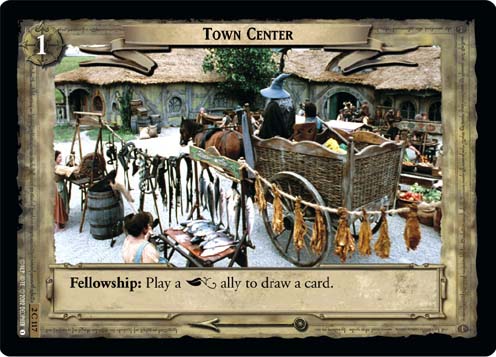
-
Bag End (1U319)
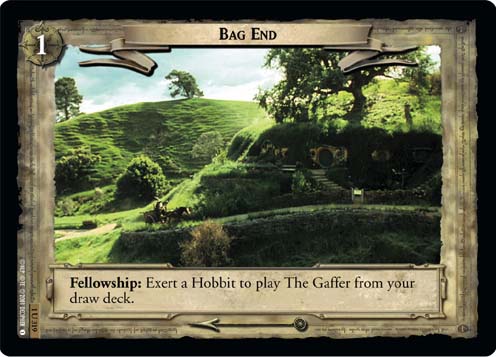
-
The Prancing Pony (1U324)
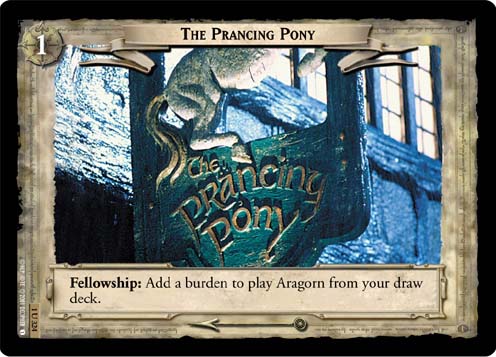
-
East Road (1U320)
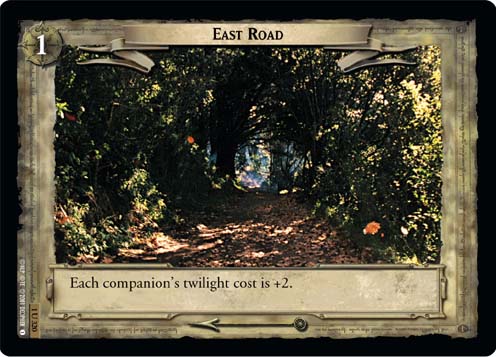
-
Green Dragon Inn (1U322)
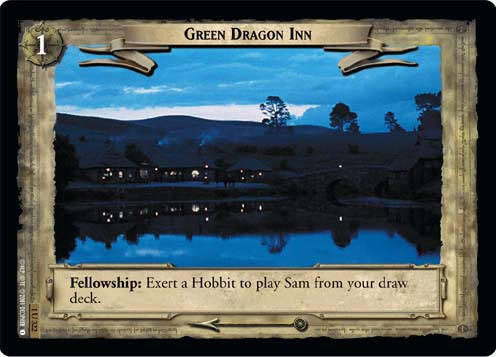
-
Farmer Maggot’s Fields (1U321)
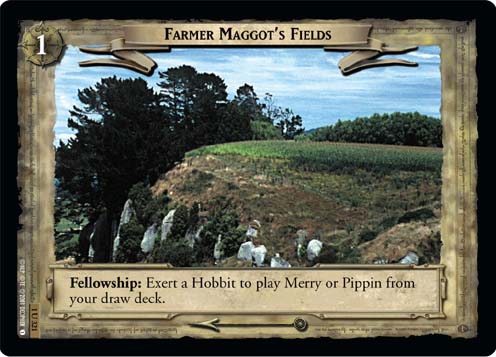
-
Green Hill Country (1U323)
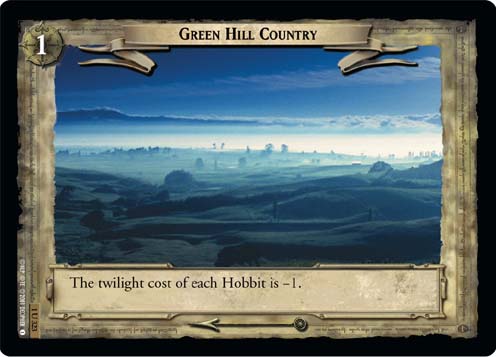
-
Westfarthing (1C326)
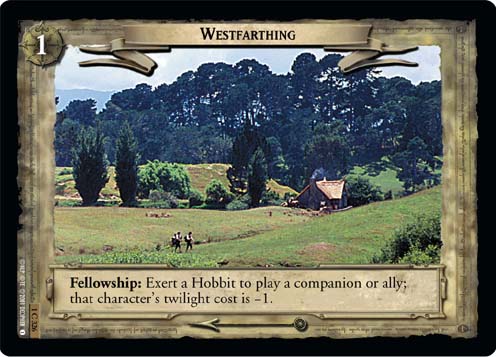
-
Hobbiton Party Field (2U115)
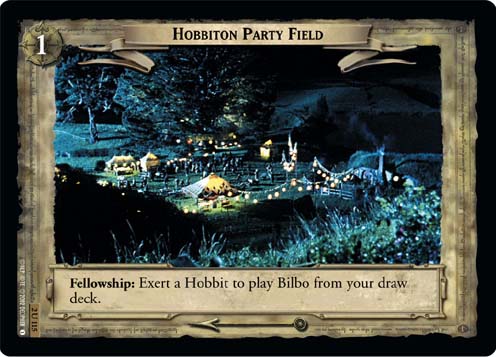
-
Hobbiton Woods (2U116)
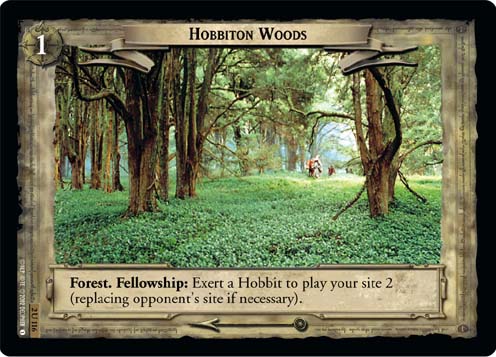
-
Shire Lookout Point (1U325)
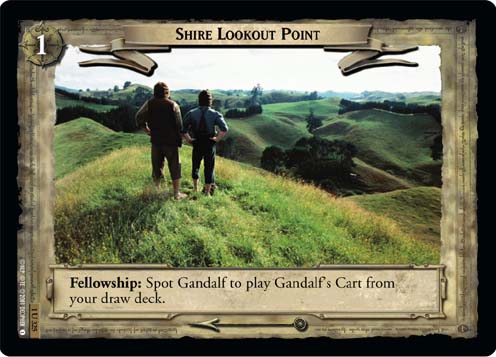
-
Weatherhills (1U335)
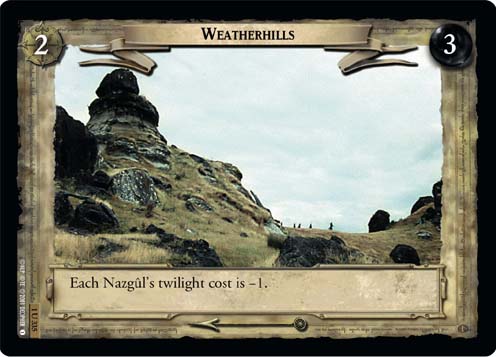
-
Trollshaw Forest (1U334)
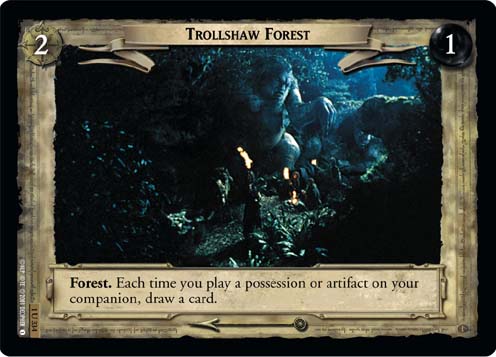
-
Bree Gate (1U327)
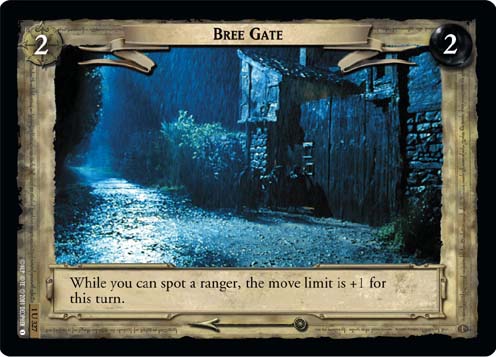
-
Breeland Forest (1U329)
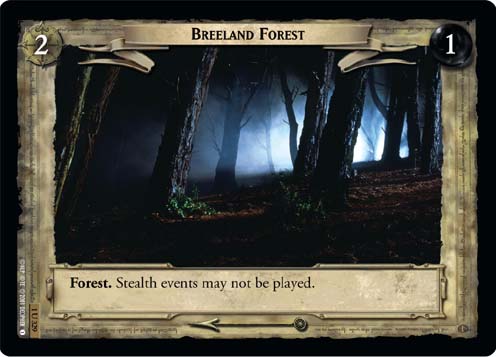
-
Midgewater Moors (1U333)
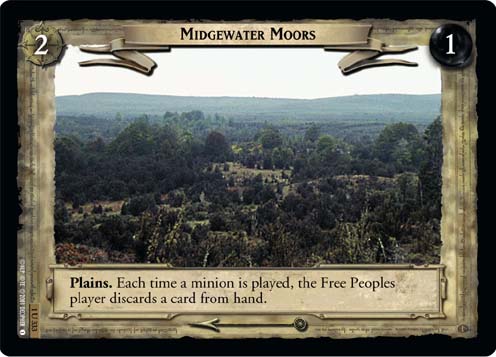
-
Ettenmoors (1C331)
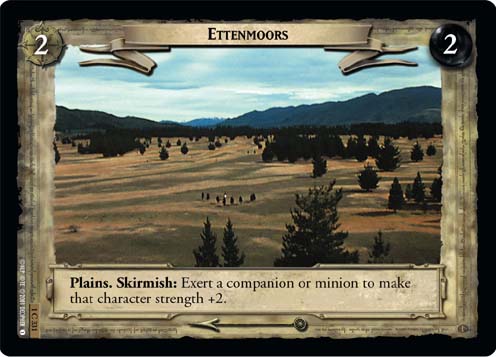
-
Weathertop (1U336)

-
Midgewater Marshes (1U332)
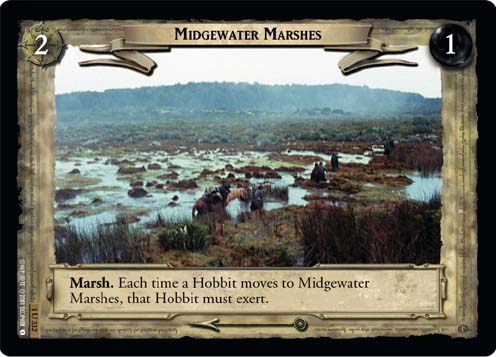
-
Bucklebury Ferry (1U330)
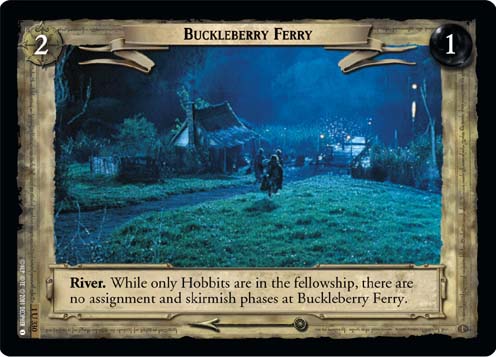
-
Bree Streets (1U328)
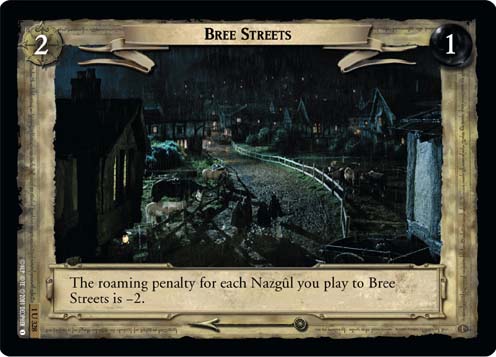
-
Ford of Bruinen (1U338)
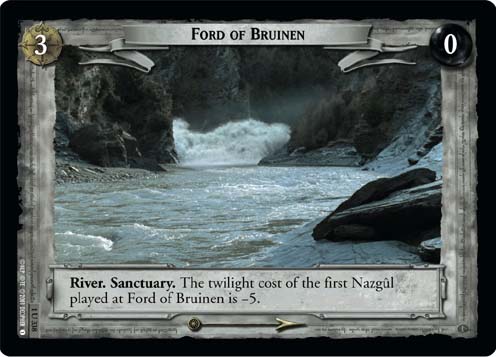
-
House of Elrond (3U119)
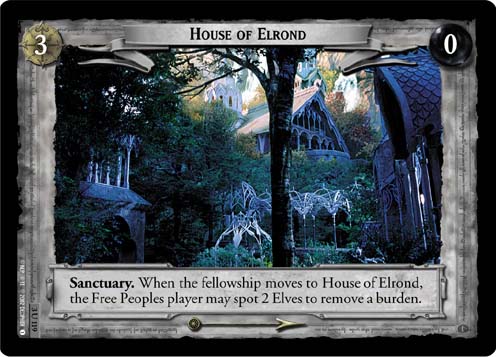
-
Rivendell Waterfall (1U342)
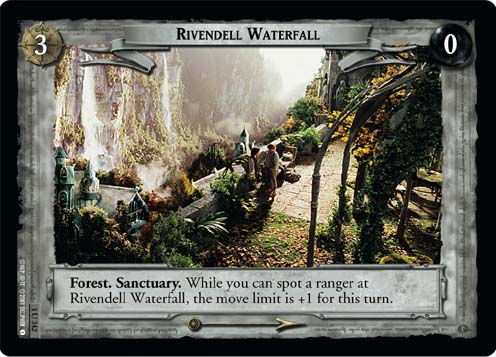
-
Rivendell Valley (1U341)
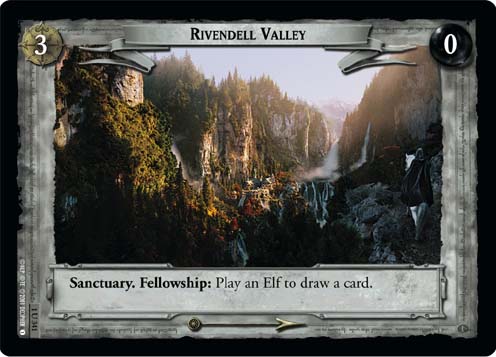
-
Frodo's Bedroom (1U339)
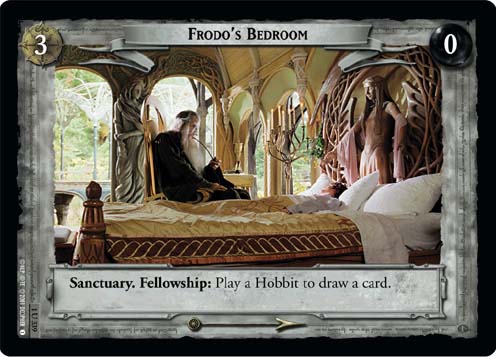
-
Rivendell Terrace (1U340)
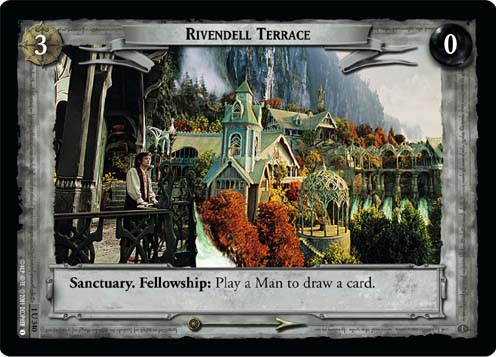
-
Council Courtyard (1C337)
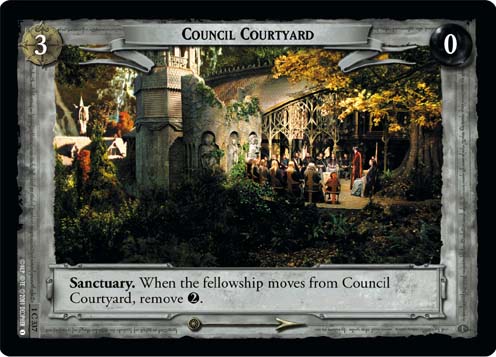
-
Mithril Mine (1U345)
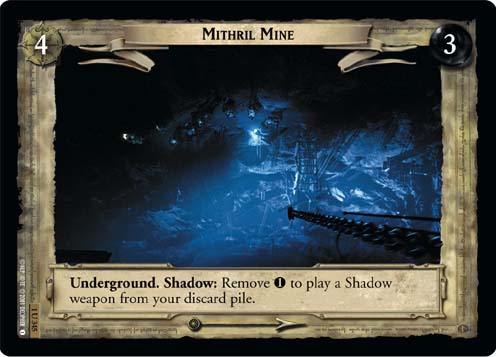
-
Moria Lake (1C346)
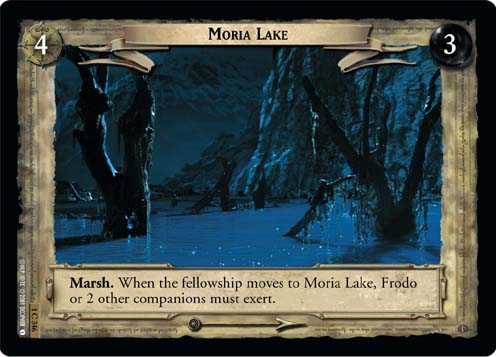
-
Hollin (2C119)
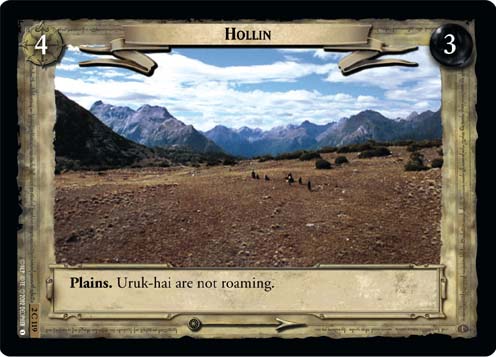
-
Great Chasm (2U118)
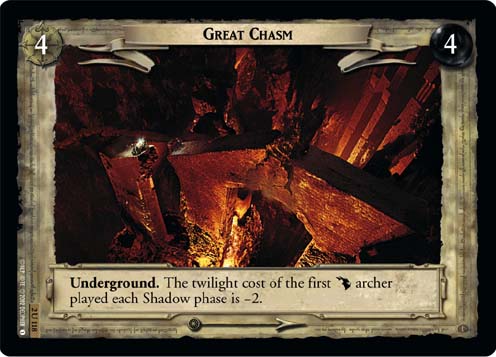
-
Moria Stairway (1U347)
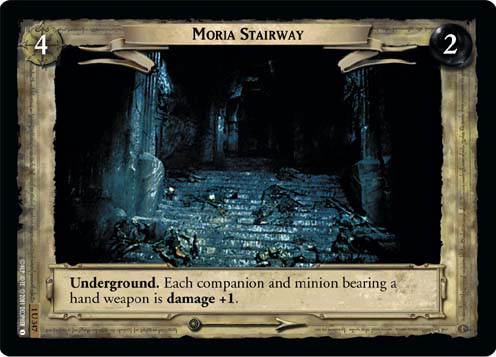
-
Dwarrowdelf Chamber (1U344)
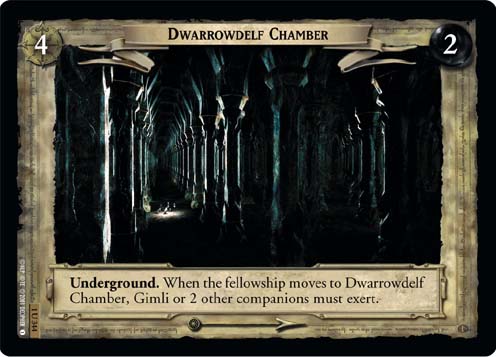
-
Balin's Tomb (1U343)
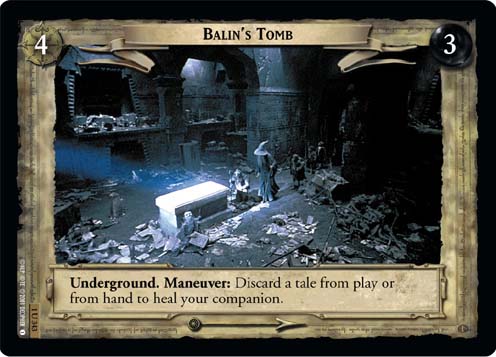
-
Pass of Caradhras (1U348)
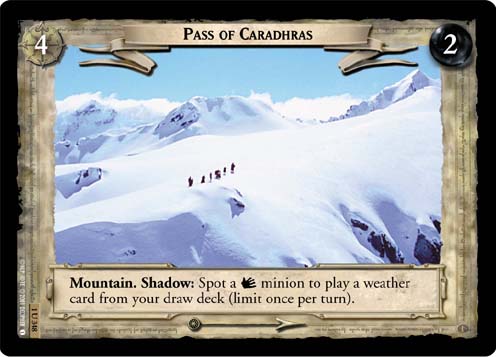
-
Eregion Hills (3U116)
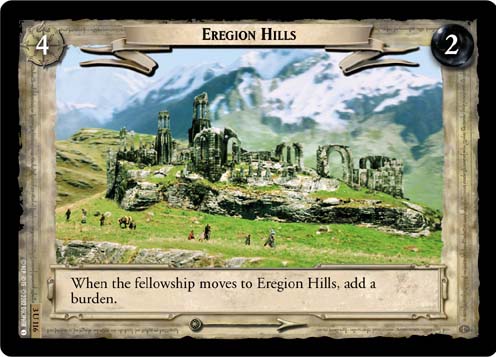
-
The Bridge of Khazad-dûm (1C349)
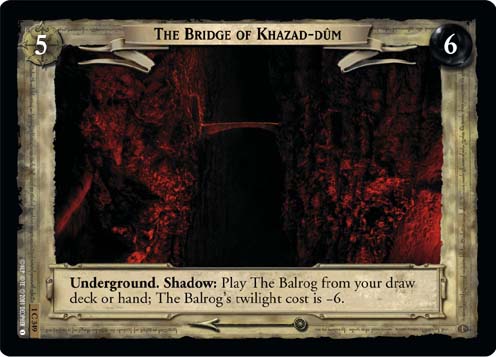
-
Galadriel's Glade (1C351)
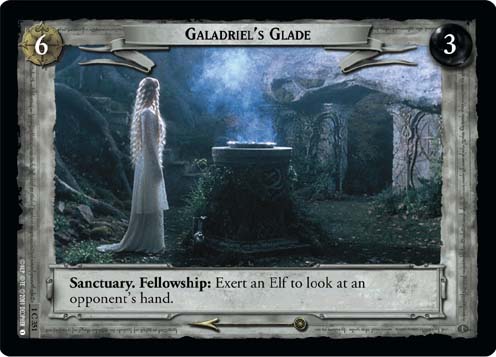
-
Caras Galadhon (3U115)
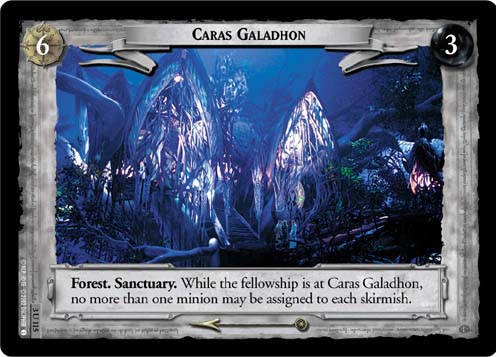
-
Valley of the Silverlode (2U120)
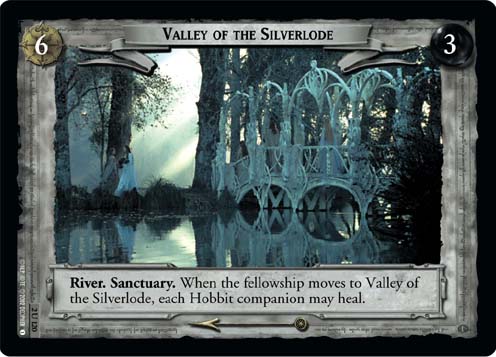
-
Lothlórien Woods (1U352)
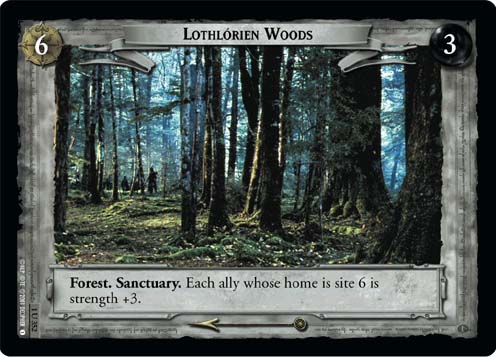
-
Dimrill Dale (1U350)
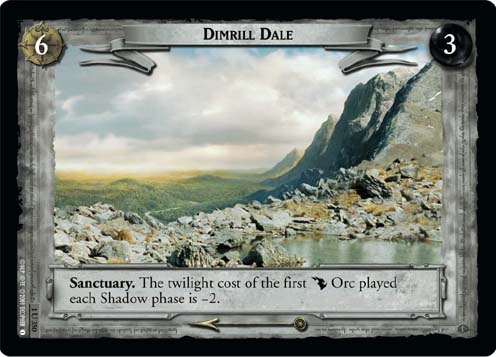
-
Anduin Wilderland (1C354)
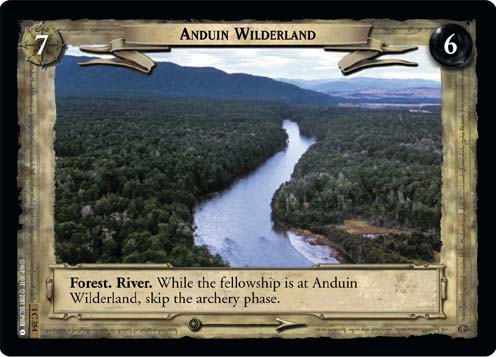
-
Silverlode Banks (1U355)
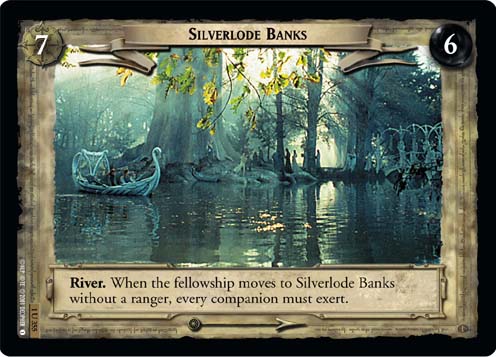
-
Anduin Confluence (1U353)
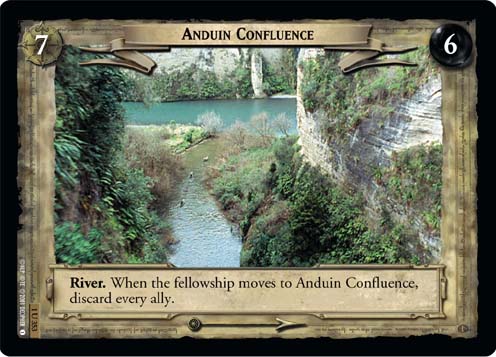
-
The Great River (3C118)
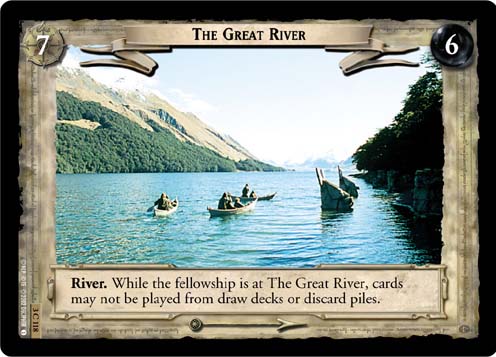
-
Anduin Banks (1C356)
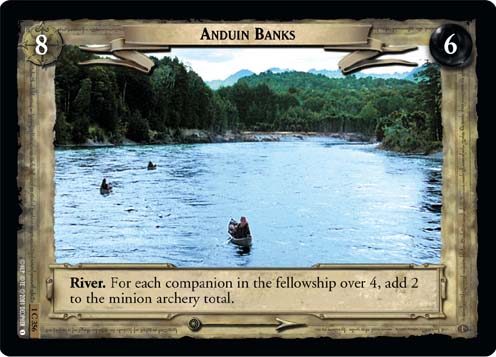
-
Shores of Nen Hithoel (1U359)
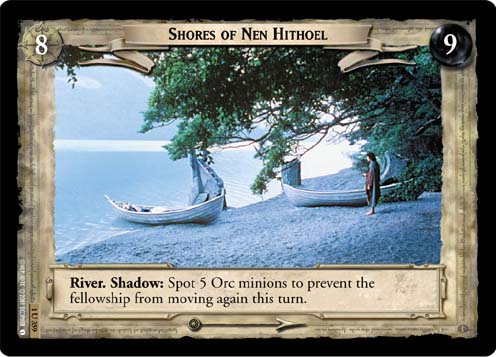
-
Gates of Argonath (3C117)
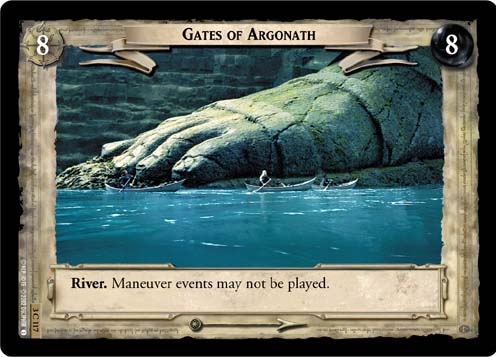
-
Brown Lands (1U357)
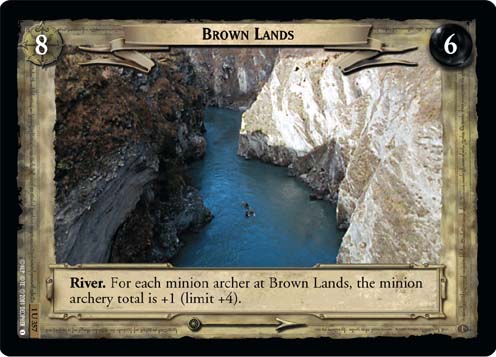
-
Pillars of the Kings (1U358)
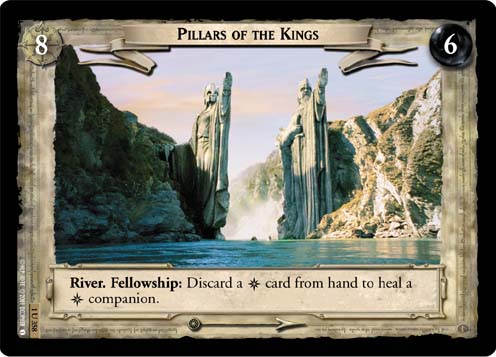
-
Slopes of Amon Hen (1U361)
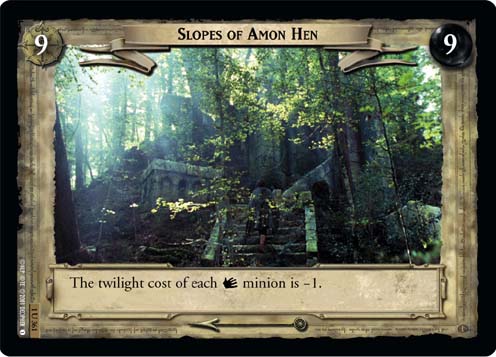
-
Emyn Muil (1U360)
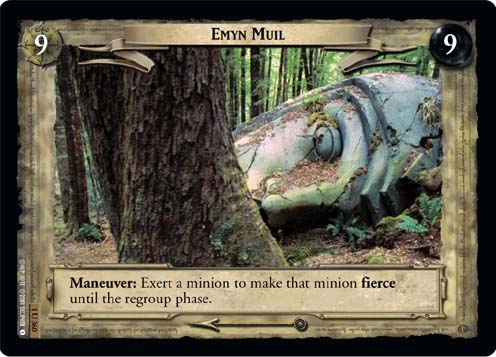
-
Summit of Amon Hen (1C362)
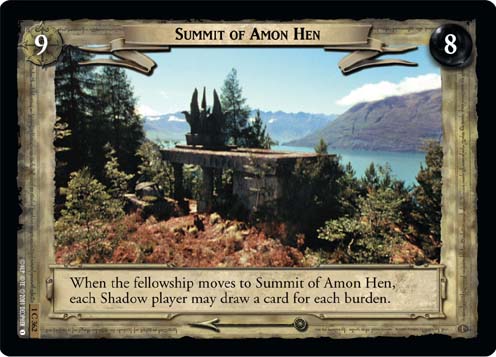
-
Wastes of Emyn Muil (3U120)
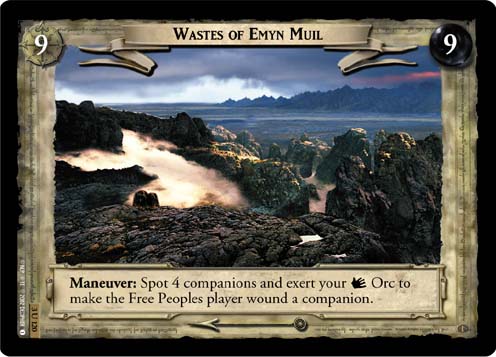
-
Tol Brandir (1U363)
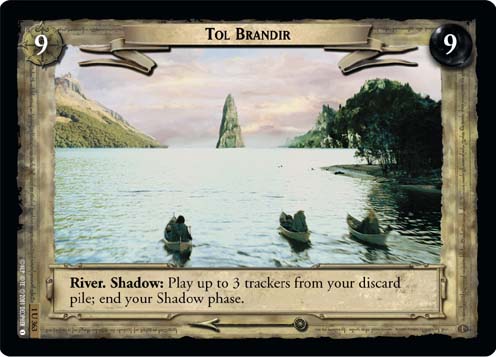
List of Towers Block Sites[edit]
-
Eastemnet Gullies (4U325)
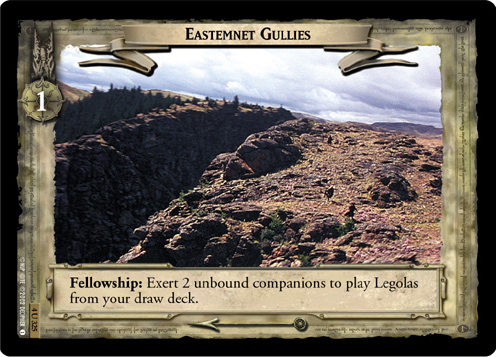
-
Westfold (6U116)
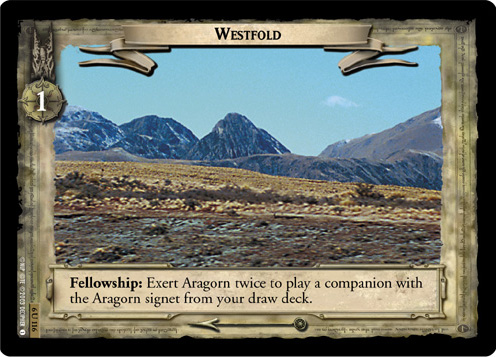
-
East Wall of Rohan (4U323)
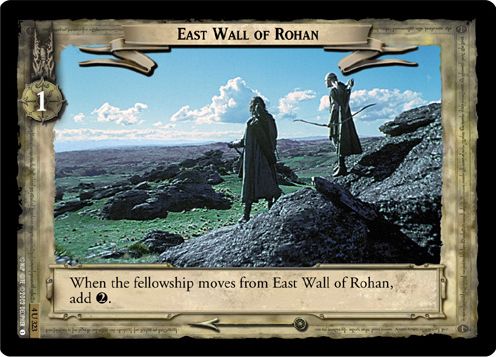
-
Rocks of Emyn Muil (6U115)
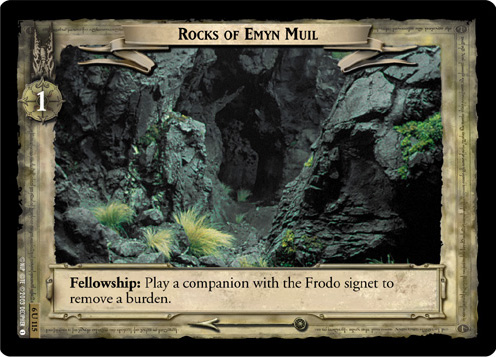
-
The Riddermark (4U328)
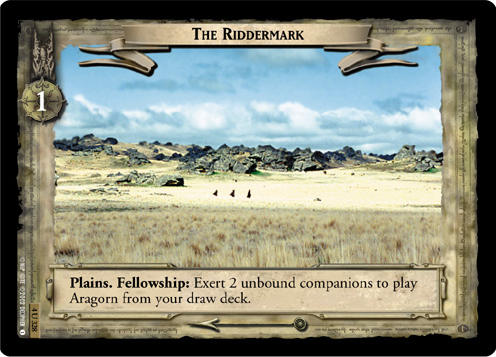
-
Western Emyn Muil (4U329)
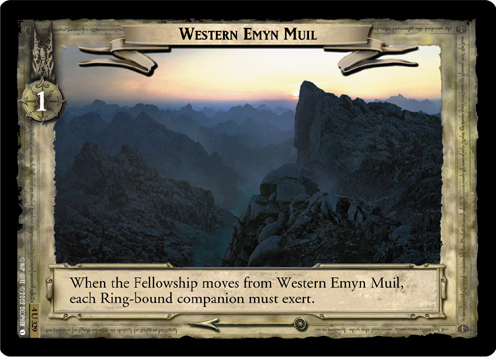
-
Plains of Rohan (4U327)
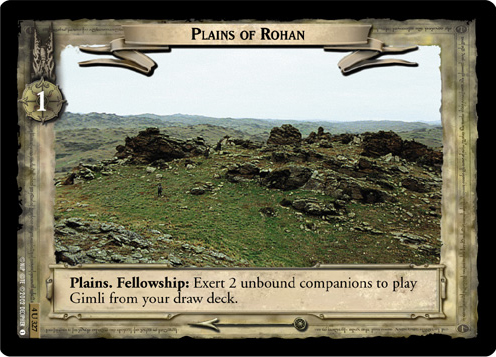
-
Horse-country (4U326)
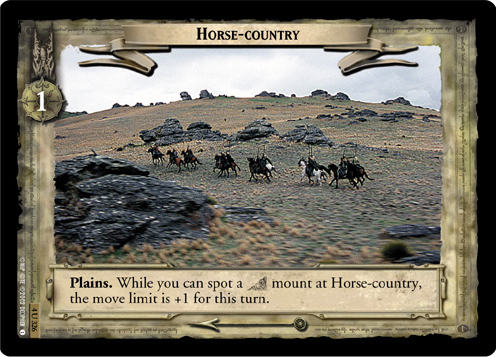
-
Eastemnet Downs (4U324)
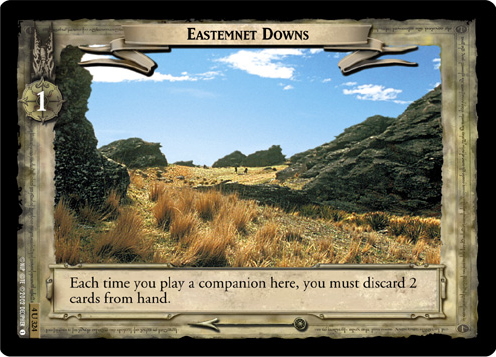
-
Rohirrim Village (4U334)
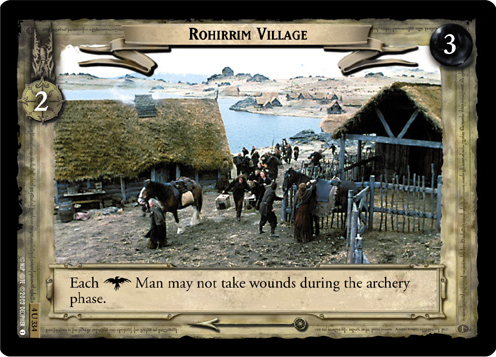
-
Eastfold (4U331)
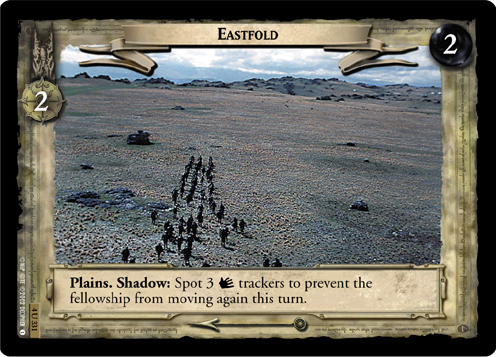
-
Fangorn Forest (4U332)
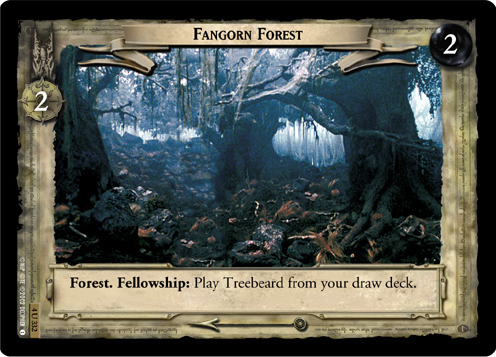
-
Derndingle (4U330)
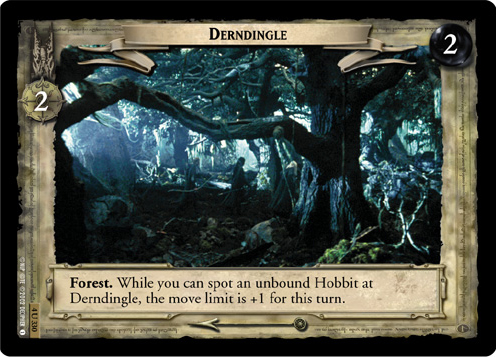
-
Wold of Rohan (4U336)
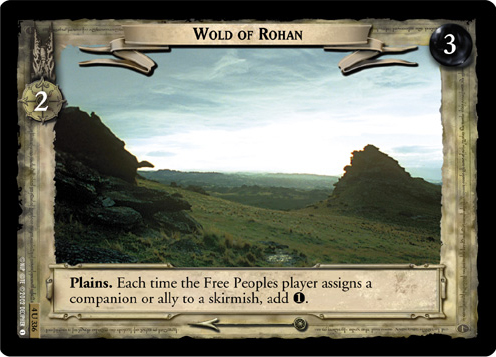
-
Uruk Camp (4U335)
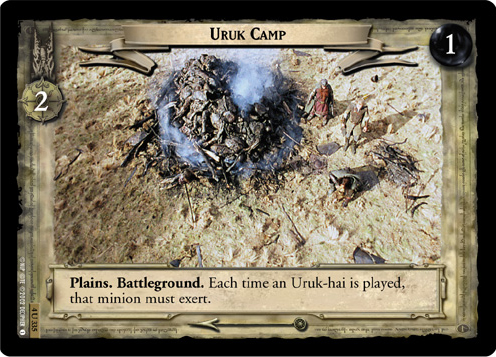
-
Plains of Rohan Camp (4U333)
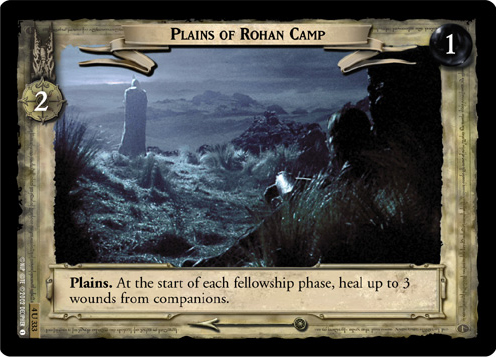
-
Stables (4U339)
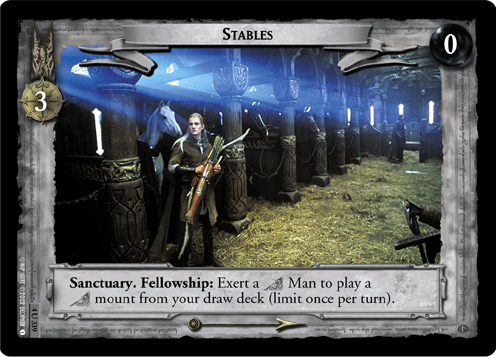
-
Barrows of Edoras (4U337)
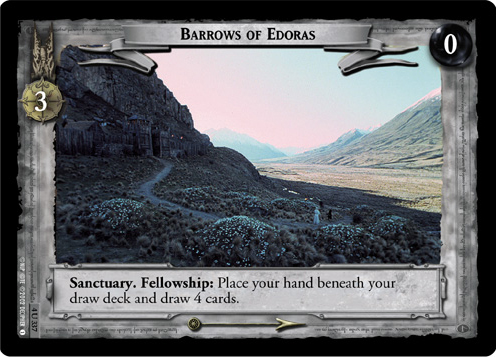
-
Streets of Edoras (4U340)

-
Throne Room (4U341)
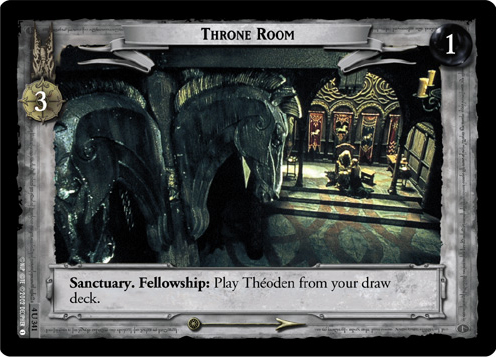
-
Golden Hall (4U338)
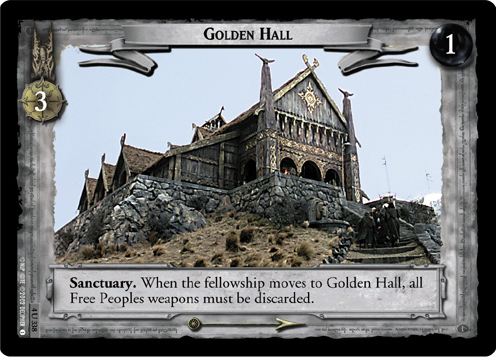
-
Meduseld (6U117)
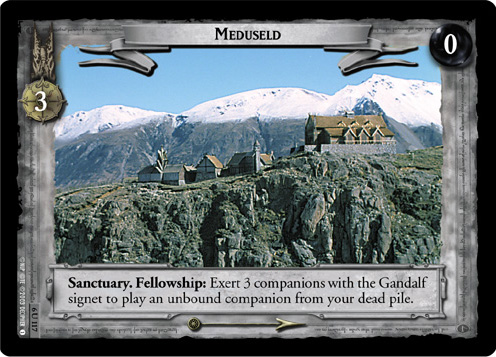
-
Westemnet Plains (4U342)
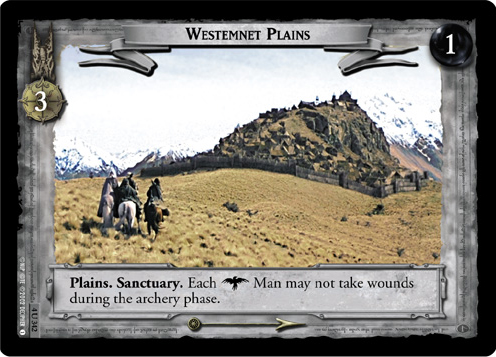
-
Westemnet Hills (4U344)
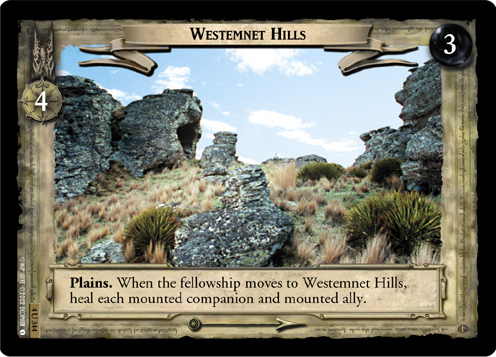
-
White Rocks (4U346)
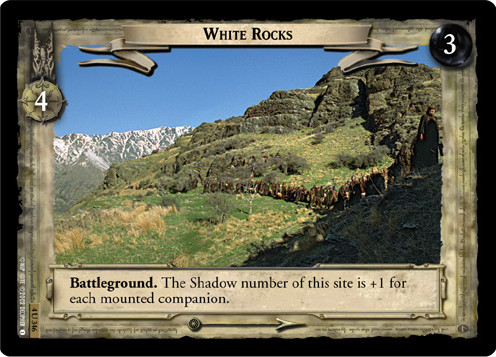
-
Ered Nimrais (4U343)
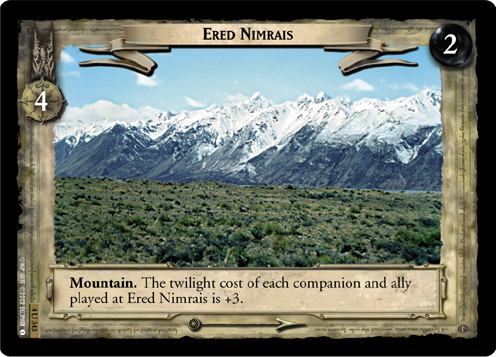
-
White Mountains (4U345)
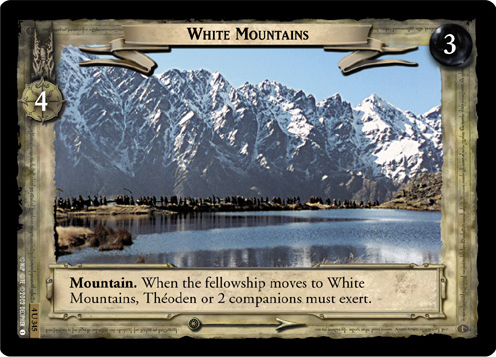
-
Helm's Gate (4U349)
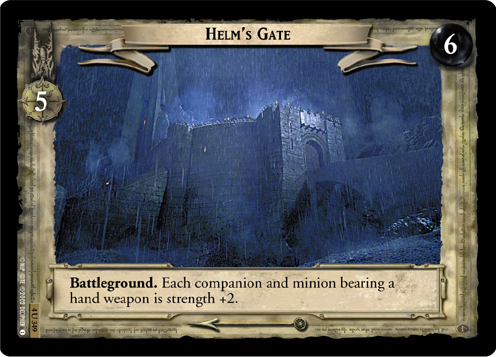
-
Hornburg Parapet (4U351)
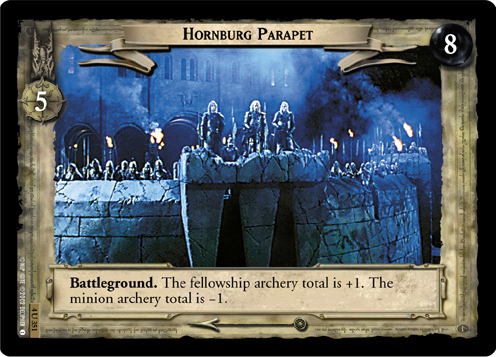
-
Deep of Helm (4U347)
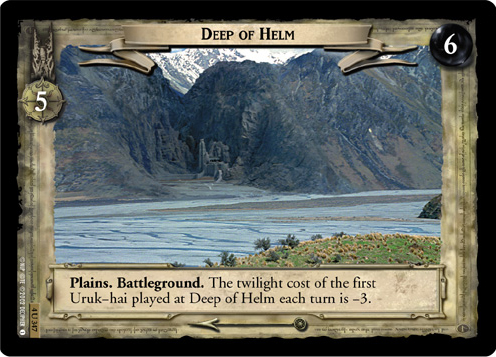
-
Hornburg Courtyard (4U350)
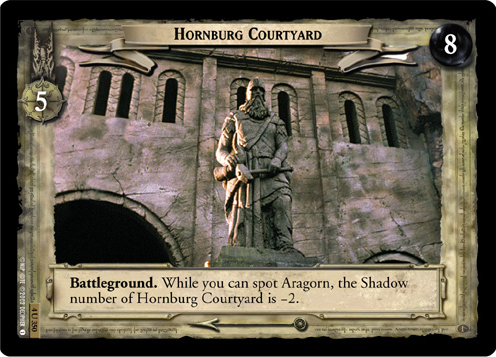
-
Deeping Wall (4U348)
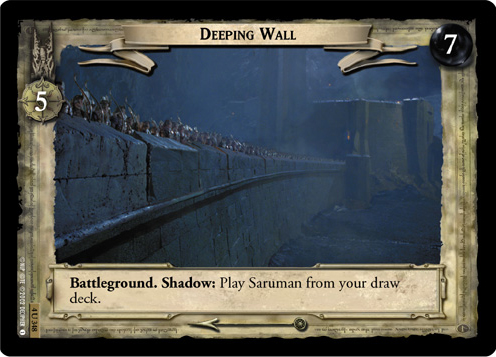
-
Great Hall (4U353)
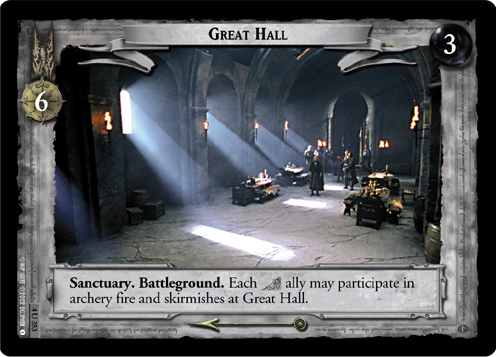
-
Hornburg Armory (4U354)
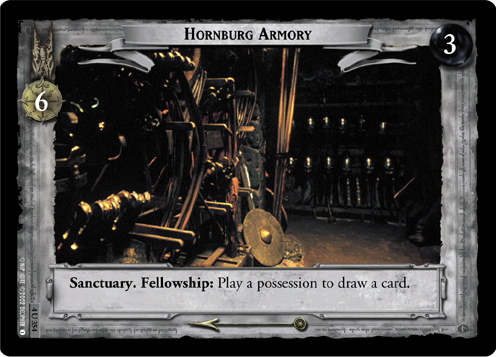
-
Caves of Aglarond (4U352)
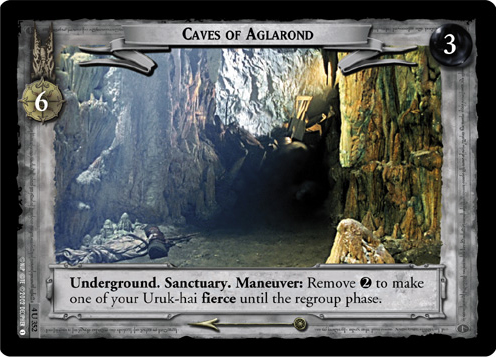
-
Hornburg Hall (6U118)
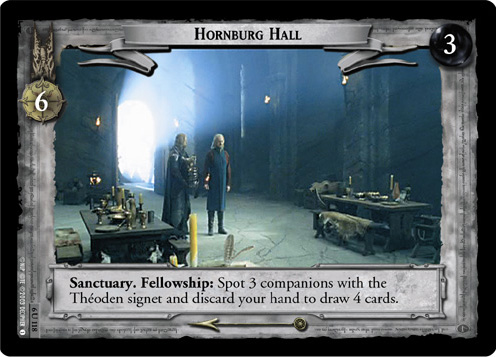
-
Hornburg Wall (5U118)
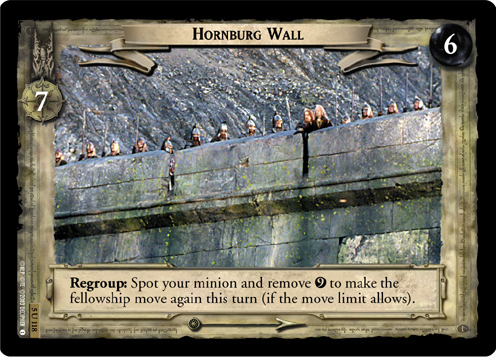
-
King's Room (4U357)
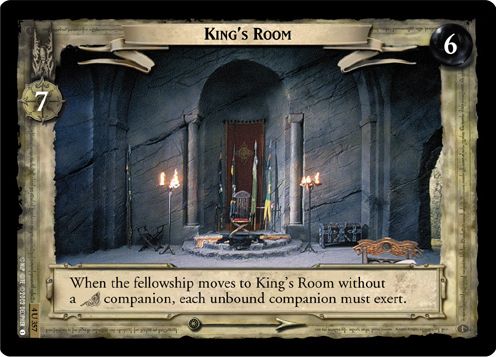
-
Hornburg Causeway (4U356)
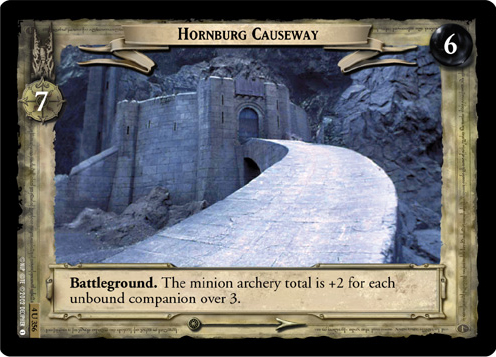
-
Cavern Entrance (4U355)
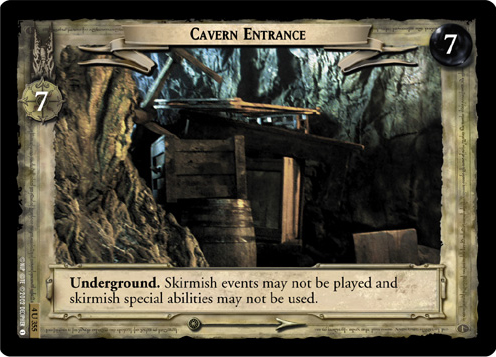
-
Valley of Saruman (6U119)
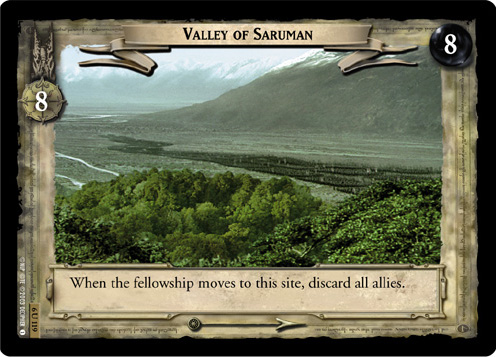
-
Ring of Isengard (4U358)
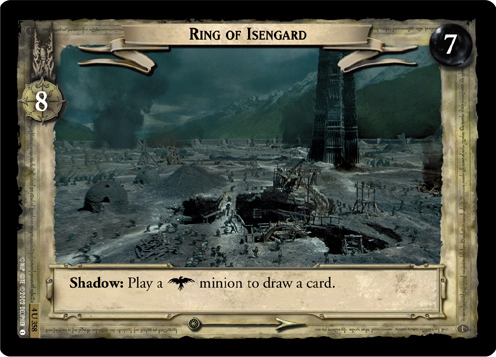
-
Nan Curunír (5U119)
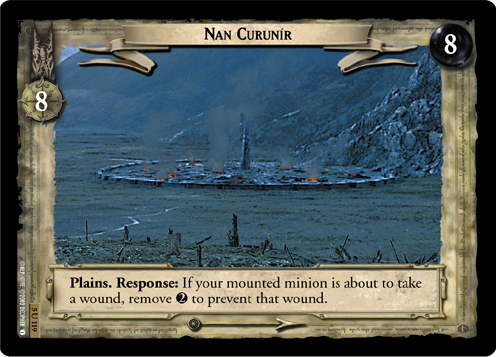
-
Wizard's Vale (4U359)
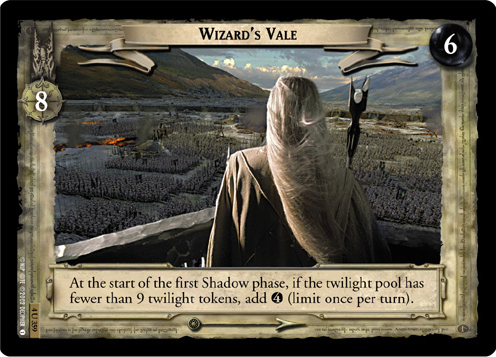
-
Orthanc Library (4U362)
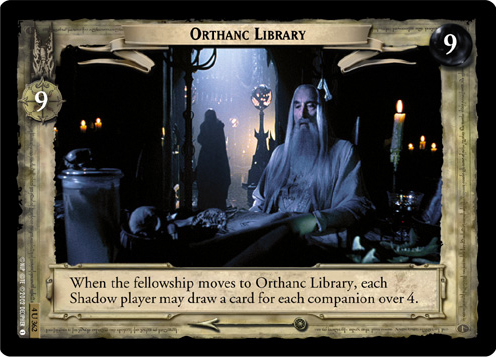
-
Palantír Chamber (4U363)
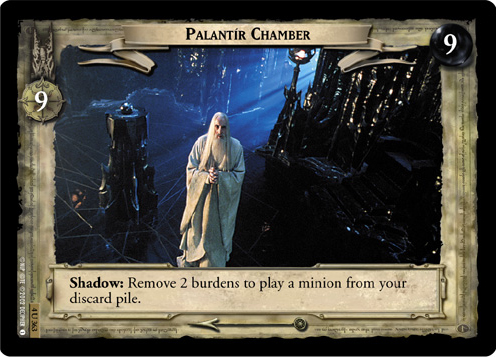
-
Orthanc Balcony (4U361)
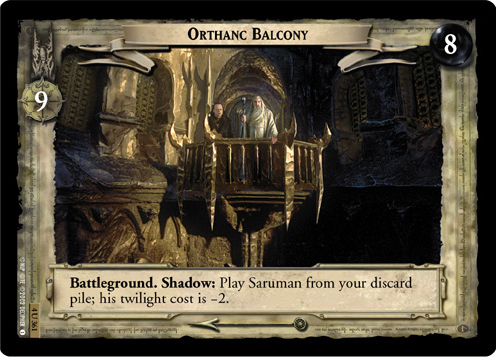
-
Caverns of Isengard (5U120)
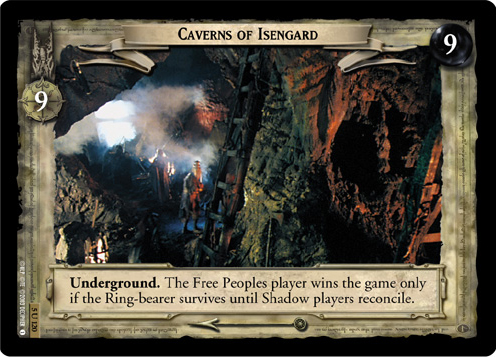
-
Fortress of Orthanc (4U360)
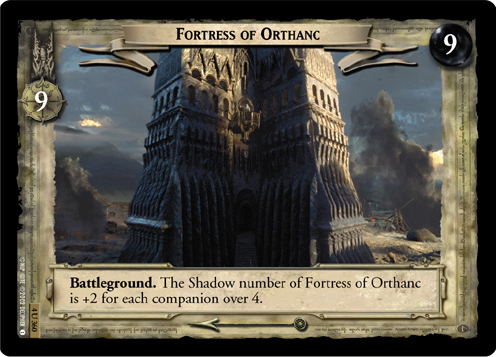
-
Saruman’s Laboratory (6U120)
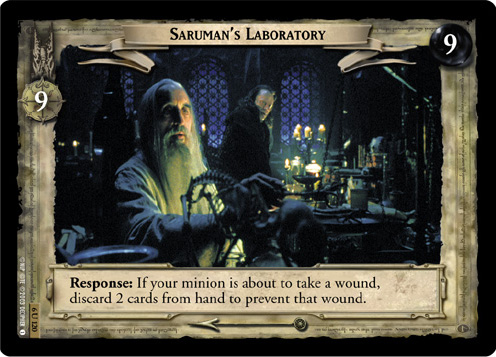
List of King Block Sites[edit]
The King Block site path is used for Movie Block, the somewhat less-popular King Standard format, and the rarely-played King Block format. Since most of the sites are fairly general, the same considerations more or less apply in all three formats.
At site 1, most of the options choke, reducing the twilight pool for decks using three hobbits, an elf, or Rohan mounts. One notable option can help
Dwarven decks set up a key condition, and it's often important enough that they bid just to get their starting site. The other options are negligible bonuses for Gandalf or
Gondor and rarely used. Except for Dunharrow Plateau (7U329)
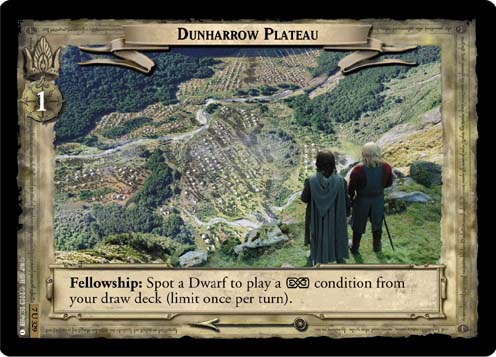 , the impact is generally minimal.
, the impact is generally minimal.
Site 2 goes the other way, punishing a Free Peoples player who loses initiative by playing too many cards on their first turn. The punishment varies depending on the site: two options make it easier to play minions (and are more or less interchangeable), while one simply stops the Free Peoples player as long as the Shadow player plays at least one minion. Again, these sites are mostly interchangeable depending on taste.
Site 3 helps Free Peoples decks set up in exchange for threats. Hall of the Kings (7U339)
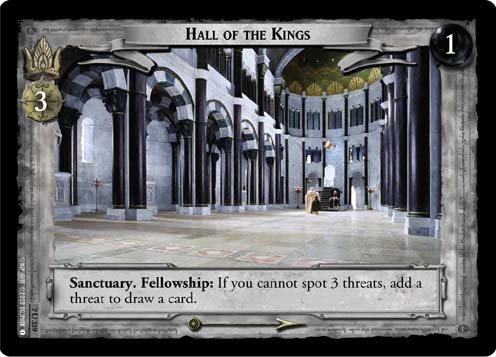 is the generically most-useful site: it's useful to any Free Peoples deck that isn't already running up against the Rule of 4 that turn. The others are more situational. The Dimholt (8U117)
is the generically most-useful site: it's useful to any Free Peoples deck that isn't already running up against the Rule of 4 that turn. The others are more situational. The Dimholt (8U117)
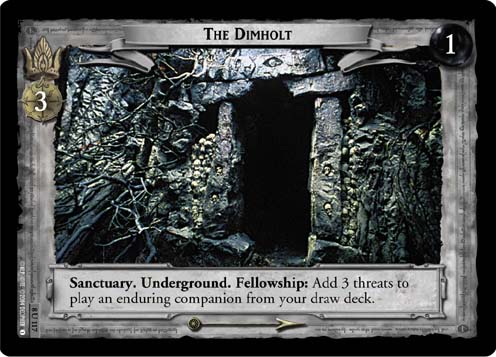 is only useful to Gondor Wraiths. Base of Mindolluin (10U117)
is only useful to Gondor Wraiths. Base of Mindolluin (10U117)
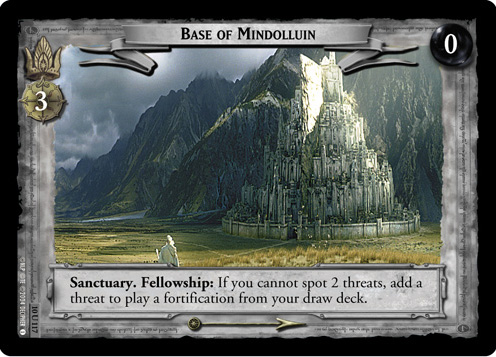 is very important to Gondor Knights (usually to grab Sixth Level (8U44)
is very important to Gondor Knights (usually to grab Sixth Level (8U44)
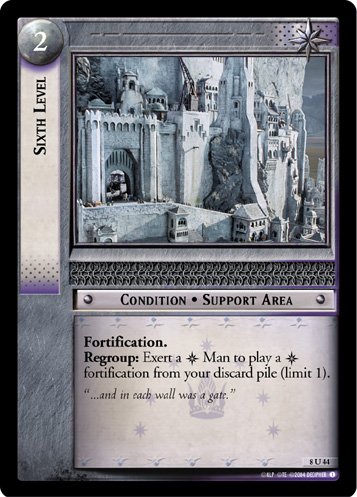 ), and largely useless for most other decks. Beacon of Minas Tirith (7U338)
), and largely useless for most other decks. Beacon of Minas Tirith (7U338)
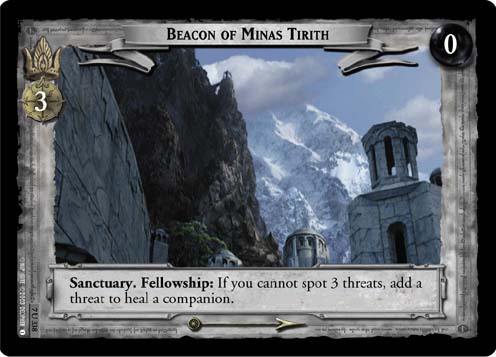 is useful to decks that want to exert a character to set up, such as decks running Denethor, Lord of Minas Tirith (10R28)
is useful to decks that want to exert a character to set up, such as decks running Denethor, Lord of Minas Tirith (10R28)
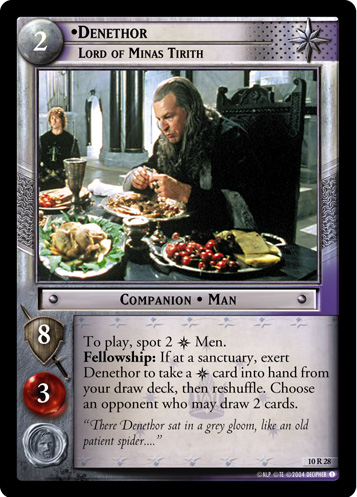 . Tower of Ecthelion (7U340)
. Tower of Ecthelion (7U340)
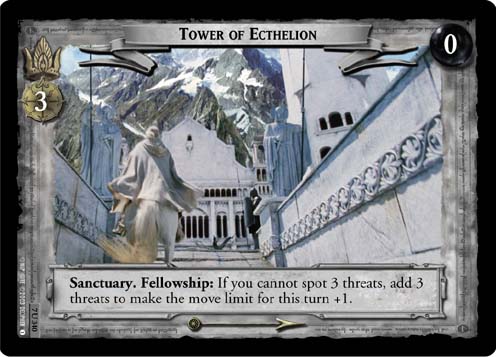 is the odd one out, since few decks in this format want to triple move from site 3 to site 6, but it's occasionally played because it's unlikely that it will ever benefit the opponent's Free Peoples deck. These sites mean that most Free Peoples decks will set some threats unless they make a conscious decision not to, and setting a threat or two in the first turn or two (perhaps with Captured by the Ring (7C53)
is the odd one out, since few decks in this format want to triple move from site 3 to site 6, but it's occasionally played because it's unlikely that it will ever benefit the opponent's Free Peoples deck. These sites mean that most Free Peoples decks will set some threats unless they make a conscious decision not to, and setting a threat or two in the first turn or two (perhaps with Captured by the Ring (7C53)
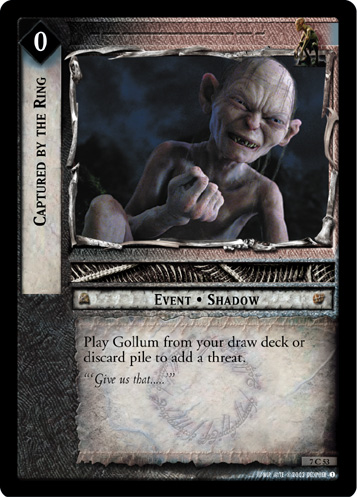 or Rallying Call (10U47)
or Rallying Call (10U47)
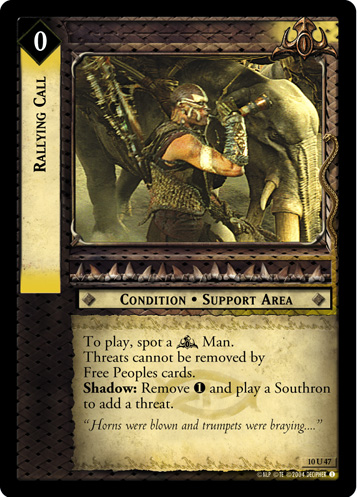 ) can slow down your opponent's Free Peoples development somewhat.
) can slow down your opponent's Free Peoples development somewhat.
Site 4 allows the Shadow player to convert any random burdens (such as from a starting bid or The One Ring, The Binding Ring (9R+1)
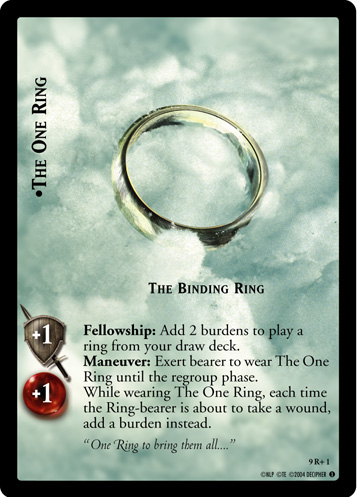 ) into some sort of benefit. Anduin Banks (7U341)
) into some sort of benefit. Anduin Banks (7U341)
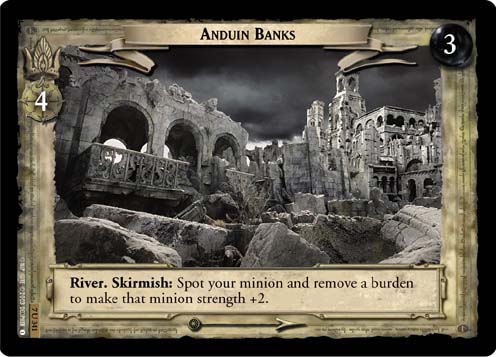 is the most generically useful to the Shadow player, although Pelennor Prairie (10U118)
is the most generically useful to the Shadow player, although Pelennor Prairie (10U118)
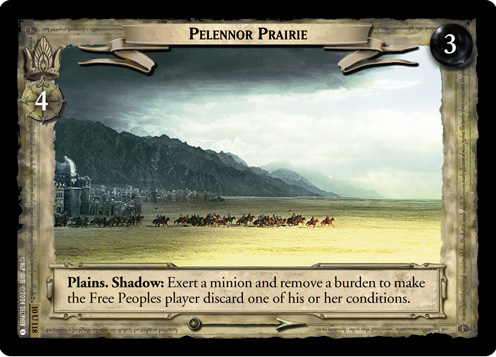 is almost as easy to use and can discard conditions that are protected by a card like Pippin, Friend to Frodo (1C306)
is almost as easy to use and can discard conditions that are protected by a card like Pippin, Friend to Frodo (1C306)
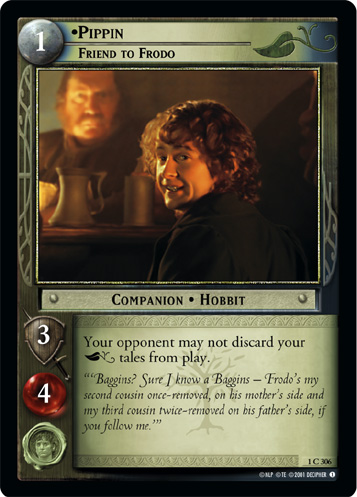 . City of the Dead (8U118)
. City of the Dead (8U118)
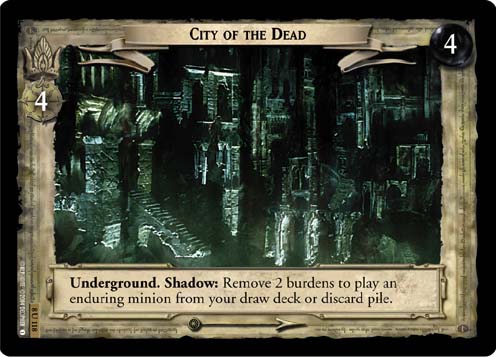 can grab powerful Enduring minions that are popular in this format, like Úlairë Enquëa, Thrall of the One (10R68)
can grab powerful Enduring minions that are popular in this format, like Úlairë Enquëa, Thrall of the One (10R68)
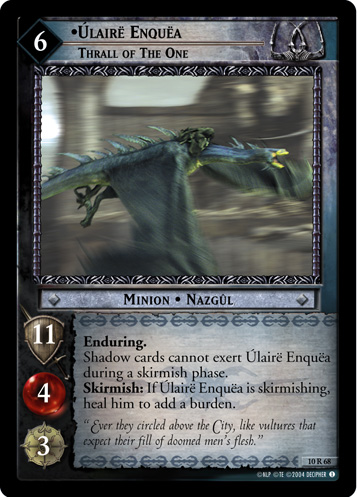 , Shelob, Her Ladyship (10R23)
, Shelob, Her Ladyship (10R23)
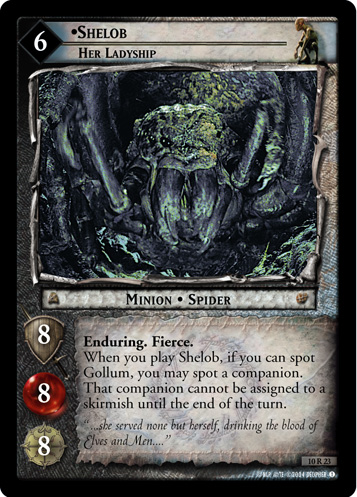 , or Orc Slaughterer (10R95)
, or Orc Slaughterer (10R95)
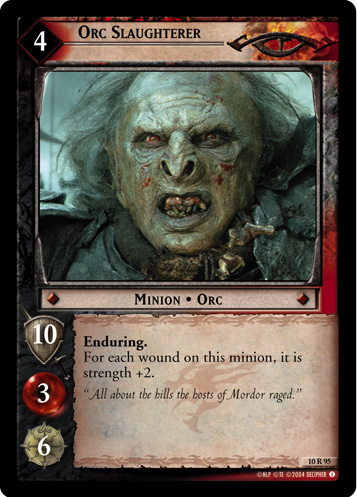 , albeit at a high cost. Osgiliath Fallen (7U342)
, albeit at a high cost. Osgiliath Fallen (7U342)
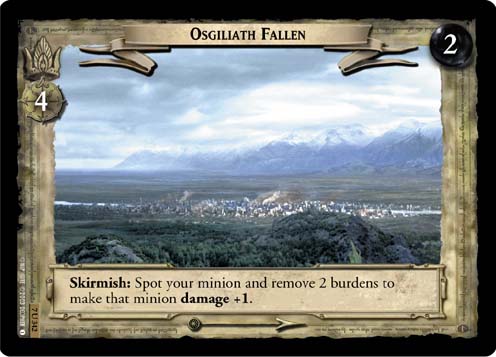 and Pelennor Plain (7U343)
and Pelennor Plain (7U343)
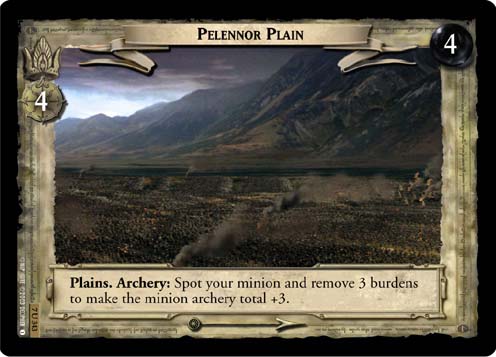 are hard for the Shadow player to use at all, but sometimes they're used specifically because of that.
are hard for the Shadow player to use at all, but sometimes they're used specifically because of that.
Site 5 is, by design, one of the hardest sites for the Free Peoples player, with relatively high twilight numbers and harsh benefits for the Shadow player, often involving a difficult choice for the Free Peoples player. All of them are popular in different decks. Steward's Tomb (10U119)
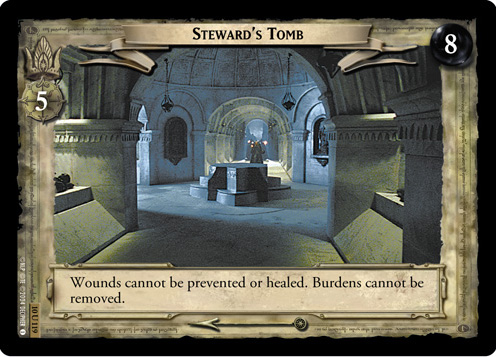 has the highest twilight number and prevents a number of defensive strategies. However, it cuts both ways:
has the highest twilight number and prevents a number of defensive strategies. However, it cuts both ways: Dunland decks can't protect their minions with Hides (4R19)
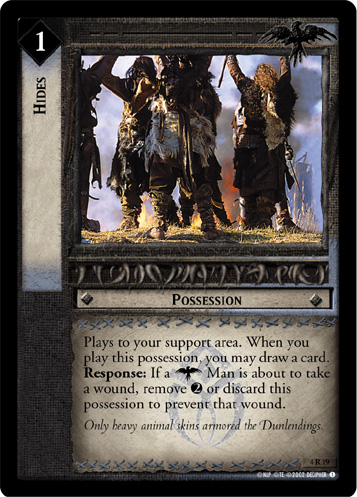 and Enduring Nazgul like Úlairë Enquëa, Thrall of the One (10R68)
and Enduring Nazgul like Úlairë Enquëa, Thrall of the One (10R68)
 can't heal themselves, so it's not well-suited to some Shadow decks. Crashed Gates
can't heal themselves, so it's not well-suited to some Shadow decks. Crashed Gates
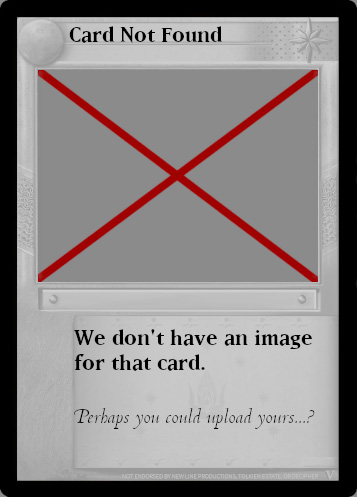 forces the Free Peoples player to choose between placing threats (assuming they have enough room after site 4!) or allowing the Shadow player to control a site. Often, players choose this site if they are running
forces the Free Peoples player to choose between placing threats (assuming they have enough room after site 4!) or allowing the Shadow player to control a site. Often, players choose this site if they are running Dunland or Besieger Shadows, or simply expect their opponents to not be running those Shadows. Pelennor Flat (7U345)
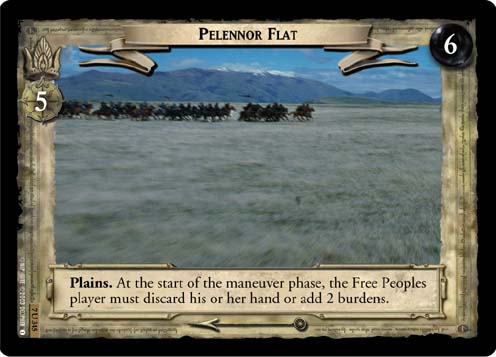 is well-suited to discard or corruption Shadows. City Gates (7U344)
is well-suited to discard or corruption Shadows. City Gates (7U344)
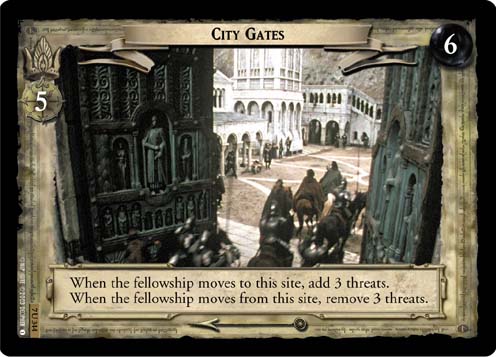 is often the least dangerous site 5, and it has the additional benefit that if you enter the site with capped threats and the Shadow doesn't make use of any of them, the site will still often remove more threats than it placed. It's handy for
is often the least dangerous site 5, and it has the additional benefit that if you enter the site with capped threats and the Shadow doesn't make use of any of them, the site will still often remove more threats than it placed. It's handy for Raiders or Sauron Threats, which will almost always make use of the threats.
Site 6 is is a rubber band, making it easier for the Free Peoples player who's behind to catch up. There are seven versions of the site, and six of them heal companions of a particular culture if you give up the sanctuary healing by double moving. (They generally heal all companions of a given culture, like Minas Tirith Second Circle (7U349)
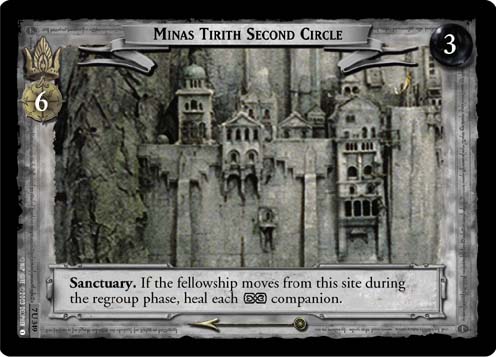 , but Minas Tirith Fifth Circle (7U346)
, but Minas Tirith Fifth Circle (7U346)
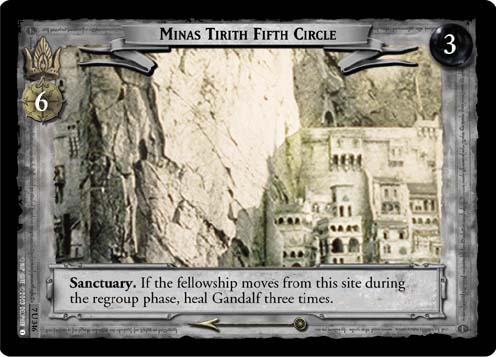 heals just heals Gandalf himself multiple times.) The seventh, Minas Tirith First Circle (7U347)
heals just heals Gandalf himself multiple times.) The seventh, Minas Tirith First Circle (7U347)
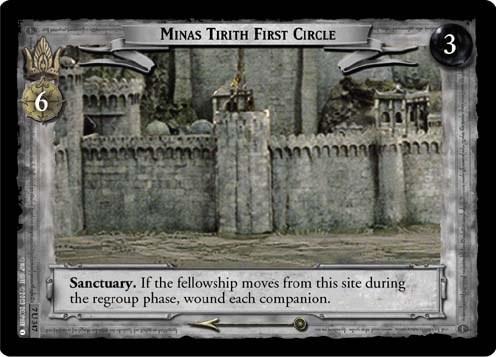 , is a rubber band that snaps on anyone trying to get ahead by bypassing site 6, with a harsh penalty that will almost always force a stop.
, is a rubber band that snaps on anyone trying to get ahead by bypassing site 6, with a harsh penalty that will almost always force a stop.
Site 7 punishes Fellowships with six or more characters in different ways, but does nothing to Fellowships that respect the Rule of 6. Notably, all of them give a consistent six twilight. Ruined Capitol (7U355)
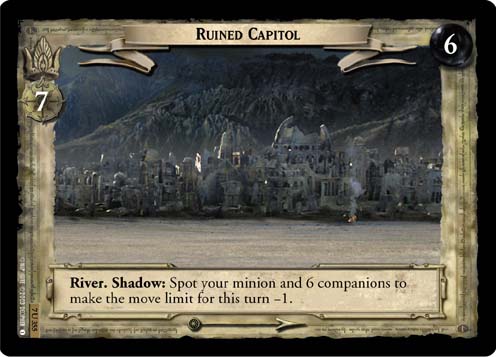 simply forces a stop as long as the Shadow player plays a minion, and it's one of the most popular choices, especially since it can't be used to punish someone going from 5-7. Osgiliath Crossing (7U353)
simply forces a stop as long as the Shadow player plays a minion, and it's one of the most popular choices, especially since it can't be used to punish someone going from 5-7. Osgiliath Crossing (7U353)
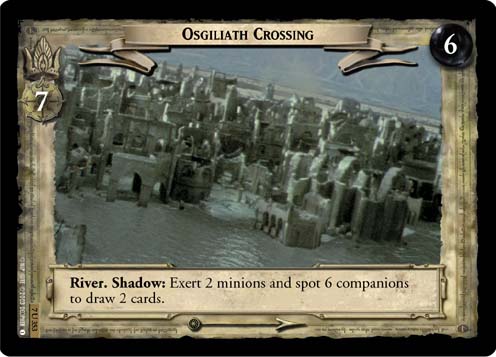 is also popular, since it allows the Shadow player to draw many cards (to use up the excessive twilight that large Fellowships often generate) while empowering their Enduring minions. Osgiliath Crossing (7U353)
is also popular, since it allows the Shadow player to draw many cards (to use up the excessive twilight that large Fellowships often generate) while empowering their Enduring minions. Osgiliath Crossing (7U353)
 can set up a deathblow by forcing the Free Peoples player to double move, although it's useless if the Free Peoples player simply wipes out all of the minions or went 5-7 that turn. Pelennor Grassland (7U354)
can set up a deathblow by forcing the Free Peoples player to double move, although it's useless if the Free Peoples player simply wipes out all of the minions or went 5-7 that turn. Pelennor Grassland (7U354)
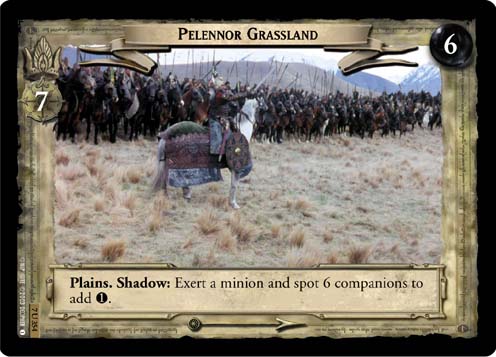 has almost no effect except maybe helping Enduring minions, so it can be useful in decks that plan to reach site 7 with a large Fellowship.
has almost no effect except maybe helping Enduring minions, so it can be useful in decks that plan to reach site 7 with a large Fellowship.
Site 8 offers culture-specific benefits to the Shadow player at the cost of consuming threats, but, unfortunately, not all Shadow cultures have a site, and some of the benefits are not great. As with site 7, all of them give a consistent eight twilight. Morgulduin (7U358)
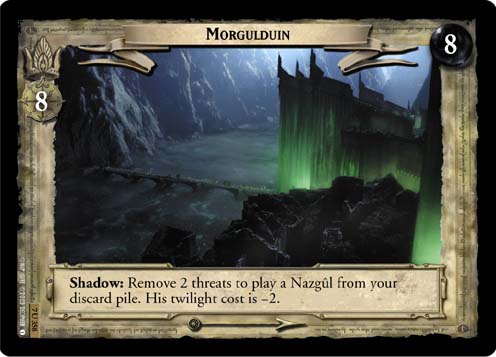 is one of the best, and so strong that many non-
is one of the best, and so strong that many non- Ringwraith decks use it to retrieve a utility Nazgul like Úlairë Enquëa, Lieutenant of Morgul (1U231)
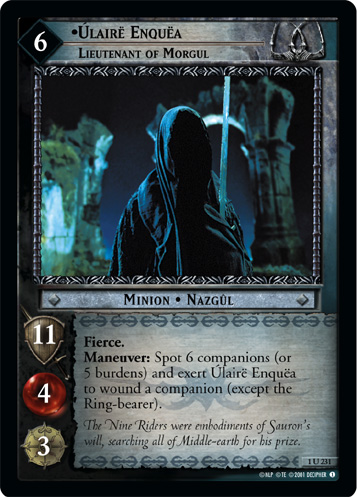 . Northern Ithilien (7U359)
. Northern Ithilien (7U359)
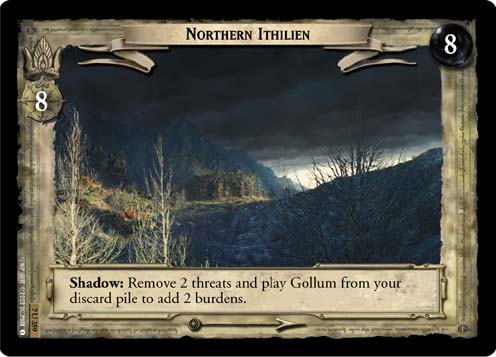 is also popular, and works well with a deck using a
is also popular, and works well with a deck using a Gollum splash, turning the threats from Captured by the Ring (7C53)
 into burdens. Morgul Vale (7U357)
into burdens. Morgul Vale (7U357)
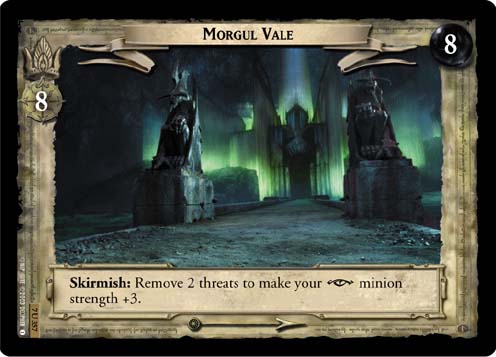 is a serviceable benefit for
is a serviceable benefit for Sauron decks. Cross Roads (7U356)
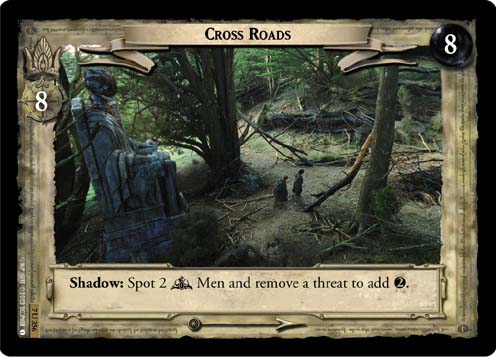 is marginal: most
is marginal: most Raider decks except Easterlings have other, better uses for threats. Watchers of Cirith Ungol (10U120)
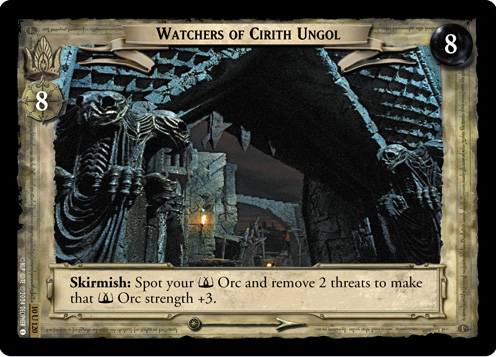 has a completely negligible effect, even for the Morc decks it's meant to enable: those decks would really rather run Morgulduin, or, failing that, spend those threats on cards like Morgul Destroyer (7U190)
has a completely negligible effect, even for the Morc decks it's meant to enable: those decks would really rather run Morgulduin, or, failing that, spend those threats on cards like Morgul Destroyer (7U190)
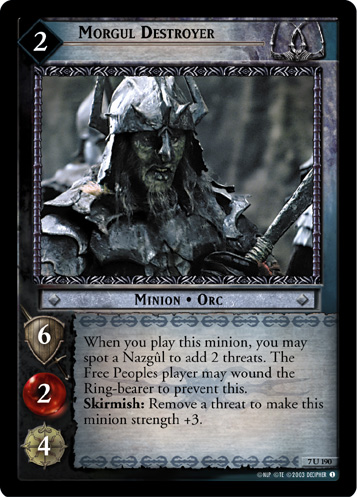 . It's occasionally used because it's terrible, since it will not benefit the opponent's Shadow hardly at all.
. It's occasionally used because it's terrible, since it will not benefit the opponent's Shadow hardly at all.
Site 9 is the endgame, and all of the options are very straightforward, and largely a matter of taste. They even all have the same twilight number: 9. It largely comes down to your Shadow deck's relationship with threats and burdens. Would you like more threats (or just a generically good site that supports almost all decks)? Dagorlad (7U360)
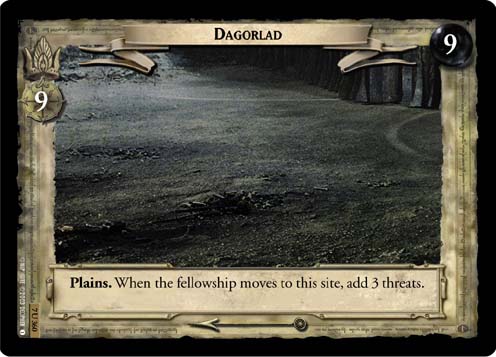 . Would you rather finish off an almost-corrupted ring-bearer? Slag Mounds (7U363)
. Would you rather finish off an almost-corrupted ring-bearer? Slag Mounds (7U363)
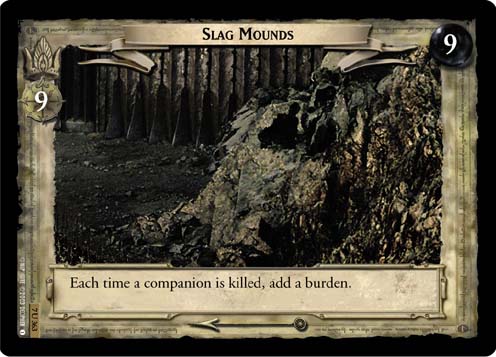 . Haunted Pass (7U361)
. Haunted Pass (7U361)
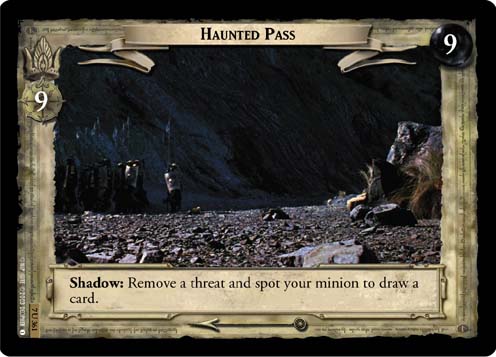 is a little shakier, since you need to consume the threats you'd certainly rather turn into wounds, but it can be worth it to make your draw more consistent or punish Free Peoples players who roll into site 9 with a large threat stack, expecting Dagorlad. The odd one out is Narchost (7U362)
is a little shakier, since you need to consume the threats you'd certainly rather turn into wounds, but it can be worth it to make your draw more consistent or punish Free Peoples players who roll into site 9 with a large threat stack, expecting Dagorlad. The odd one out is Narchost (7U362)
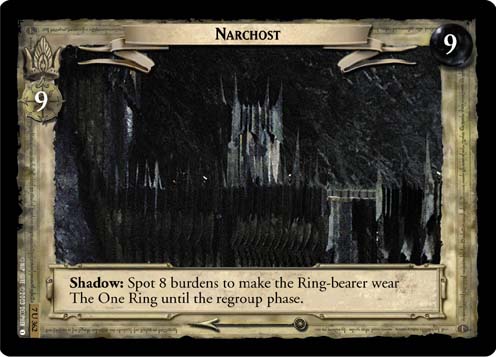 , which is worse than Slag Mounds in a corruption deck and useless to any other sort of deck, and thus almost never played.
, which is worse than Slag Mounds in a corruption deck and useless to any other sort of deck, and thus almost never played.
The site path, as a result, encourages a certain pace. Except for Dwarven decks, bidding high doesn't bring much in the way of benefits except for going first, since most of the initial sites are weak and site 4 can punish excess burdens. For the move from 1-3, it strongly discourages overplaying cards on the first turn with the site 2 penalties for losing initiative, as well as the small bonuses at site 1 to situational choke tactics. Skipping past site 3 is discouraged because, as with other formats, you're not only losing out on the healing, but also possibly the gametext helping your deck to set up. Unlike earlier formats, there's no version of site 3 that favors certain Shadow decks, though. Site 4 favors the Shadow somewhat, but site 5 is the pivot. Steward's Tomb (10U119)
 can be the hardest site in the format! A well-developed Fellowship can often go 3-5, but most often Free Peoples players who are in the lead will aim to go 3-4 then 4-6, to get the hardest move out of the way the beginning of a turn rather than the end, and follow it by moving into the relatively easier site 6. It's difficult to go 3-5, 5-7 as the player in the lead, since you'll generally get no benefit from the opponent's site 6 (and, even in a mirror match, any opponent could be running Minas Tirith First Circle (7U347)
can be the hardest site in the format! A well-developed Fellowship can often go 3-5, but most often Free Peoples players who are in the lead will aim to go 3-4 then 4-6, to get the hardest move out of the way the beginning of a turn rather than the end, and follow it by moving into the relatively easier site 6. It's difficult to go 3-5, 5-7 as the player in the lead, since you'll generally get no benefit from the opponent's site 6 (and, even in a mirror match, any opponent could be running Minas Tirith First Circle (7U347)
 against you). But a 3-5, 5-7 move is generally doable for the player trying to catch up, and it effectively blanks two of the possible sites you could face at site 7. The path also discourages decks that try to bulk up their Fellowship at site 6, because site 7 could unpredictably punish them for it. After that, it's just Shadow-favored sites to close out the game, notable mainly that they tend to interact with the threat and burden piles.
against you). But a 3-5, 5-7 move is generally doable for the player trying to catch up, and it effectively blanks two of the possible sites you could face at site 7. The path also discourages decks that try to bulk up their Fellowship at site 6, because site 7 could unpredictably punish them for it. After that, it's just Shadow-favored sites to close out the game, notable mainly that they tend to interact with the threat and burden piles.
-
Sleeping Quarters (7U333)
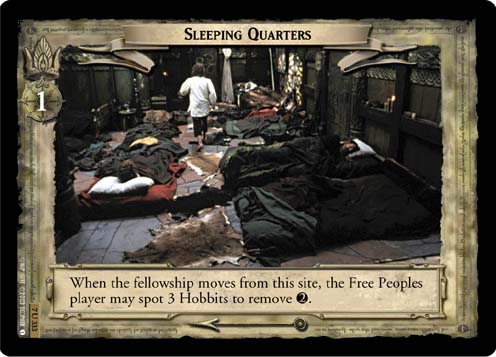
-
Edoras Hall (7U330)
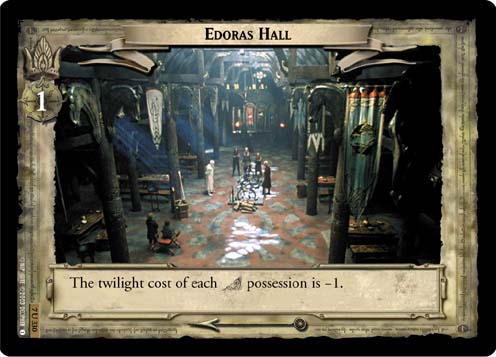
-
Rohirrim Road (7U332)
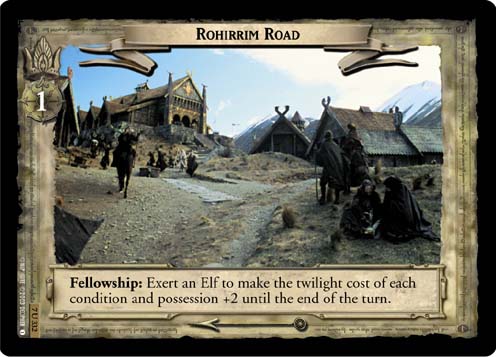
-
Dunharrow Plateau (7U329)

-
Isengard Ruined (7U331)
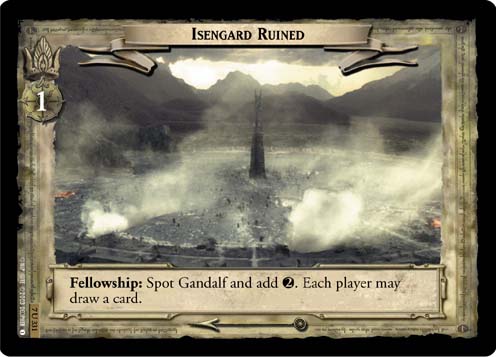
-
Steps of Edoras (7U334)
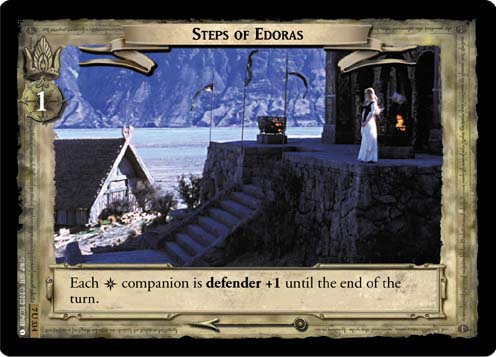
-
Rohirrim Camp (7U336)
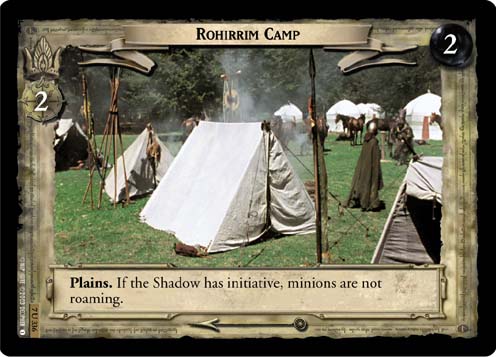
-
West Road (7U337)
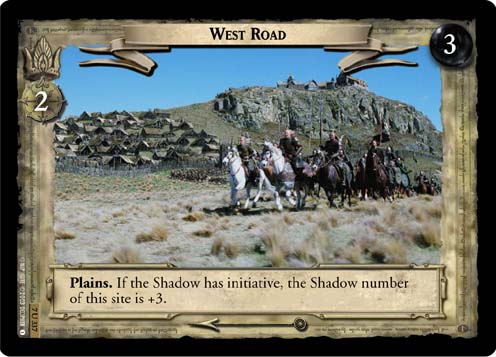
-
King's Tent (7U335)
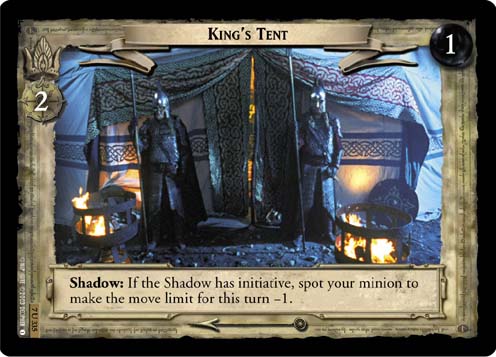
-
Base of Mindolluin (10U117)

-
Hall of the Kings (7U339)

-
Tower of Ecthelion (7U340)

-
Beacon of Minas Tirith (7U338)

-
The Dimholt (8U117)

-
Osgiliath Fallen (7U342)

-
Pelennor Prairie (10U118)

-
Pelennor Plain (7U343)

-
City of the Dead (8U118)

-
Anduin Banks (7U341)

-
City Gates (7U344)

-
Steward's Tomb (10U119)

-
Pelennor Flat (7U345)

-
Crashed Gate (8U119)
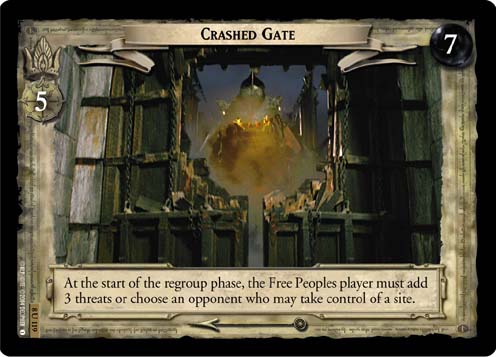
-
Minas Tirith Third Circle (7U352)
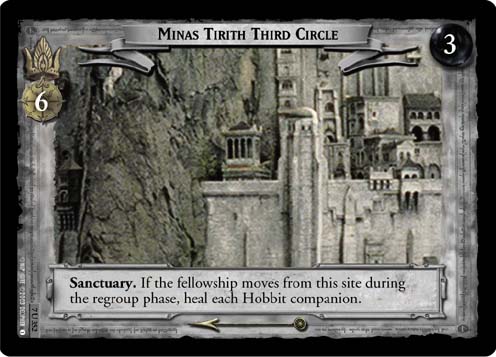
-
Minas Tirith Seventh Circle (7U350)
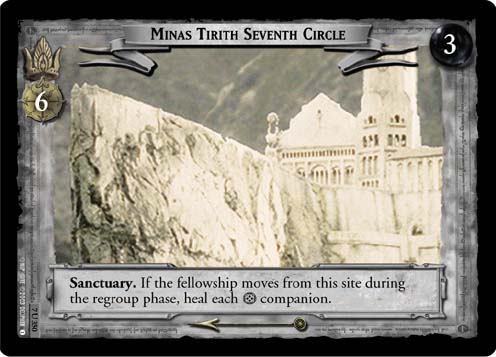
-
Minas Tirith Sixth Circle (7U351)
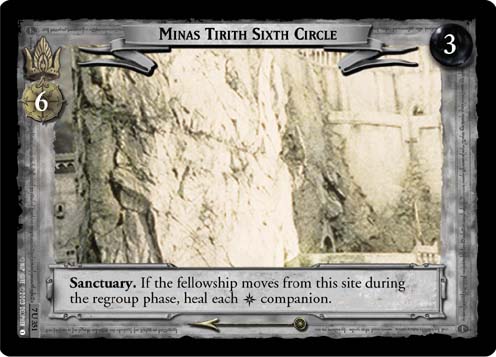
-
Minas Tirith First Circle (7U347)

-
Minas Tirith Second Circle (7U349)

-
Minas Tirith Fourth Circle (7U348)
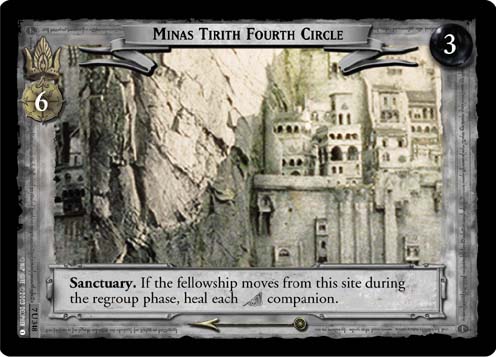
-
Minas Tirith Fifth Circle (7U346)

-
Ruined Capitol (7U355)

-
Osgiliath Crossing (7U353)

-
Osgiliath Channel (8U120)
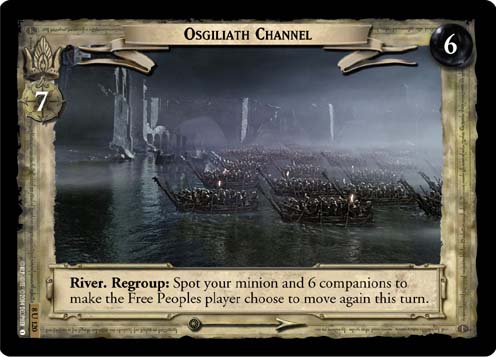
-
Pelennor Grassland (7U354)

-
Northern Ithilien (7U359)

-
Morgul Vale (7U357)

-
Morgulduin (7U358)

-
Watchers of Cirith Ungol (10U120)

-
Cross Roads (7U356)

-
Haunted Pass (7U361)

-
Narchost (7U362)

-
Dagorlad (7U360)

-
Slag Mounds (7U363)

List of War of the Ring Block Sites[edit]
-
Valley of the Silverlode (11S261)
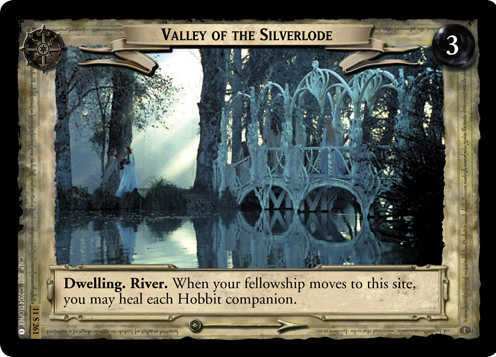
-
Flats of Rohan (11S240)
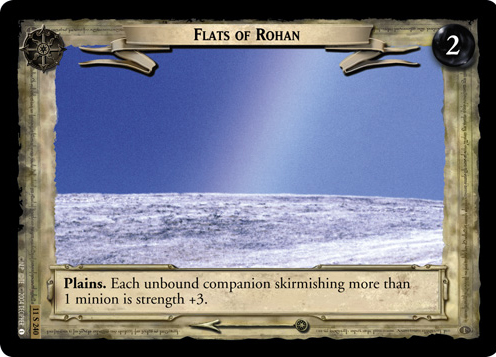
-
Pinnacle of Zirakzigil (11S255)
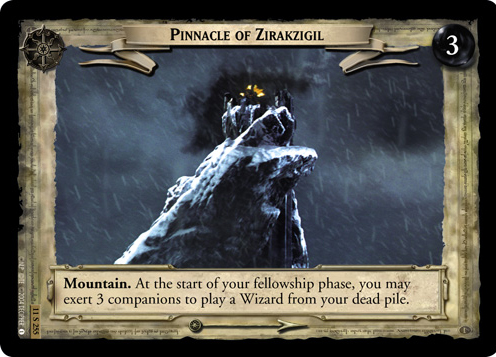
-
Barazinbar (11S229)
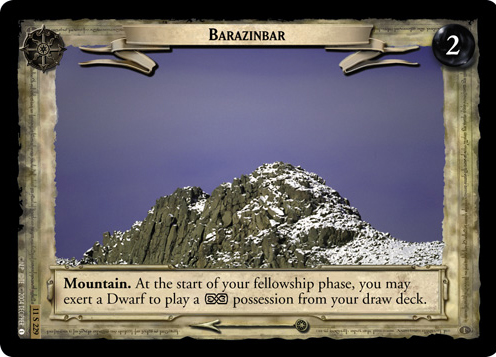
-
Doors of Durin (13U190)
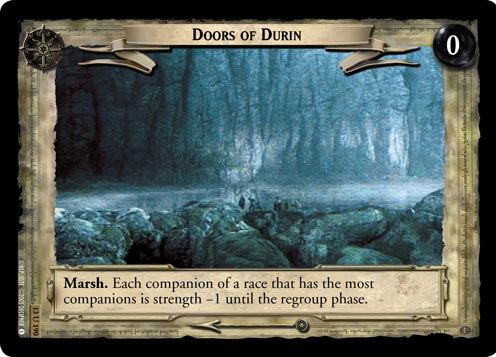
-
The Angle (12U185)
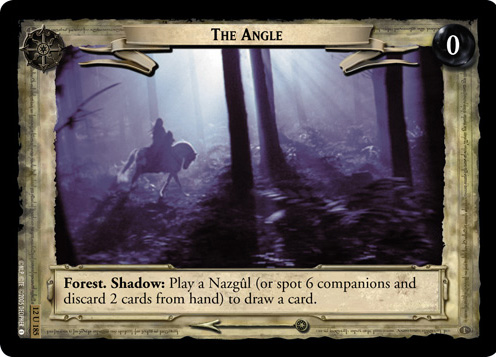
-
Moria Stairway (11S248)
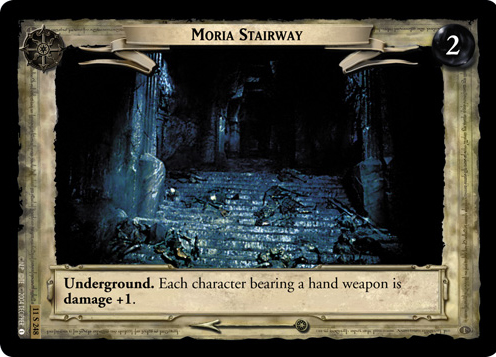
-
Cavern Entrance (11S232)
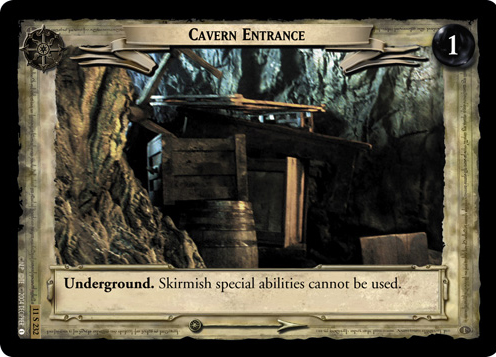
-
East Road (11S236)
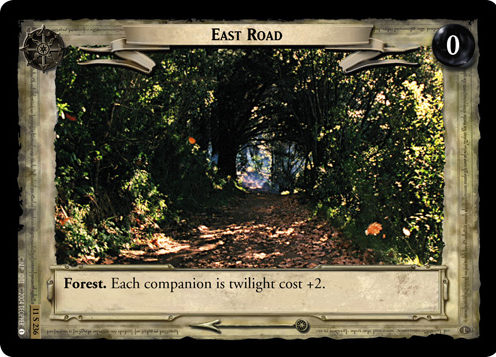
-
Slopes of Orodruin (12U192)
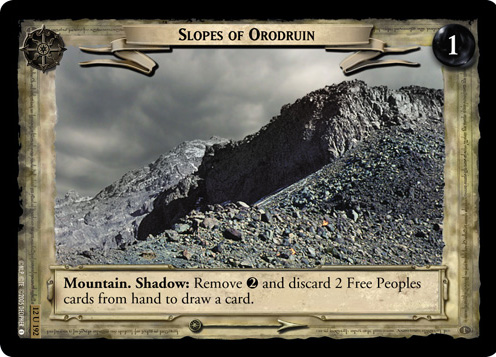
-
West Gate of Moria (11S263)
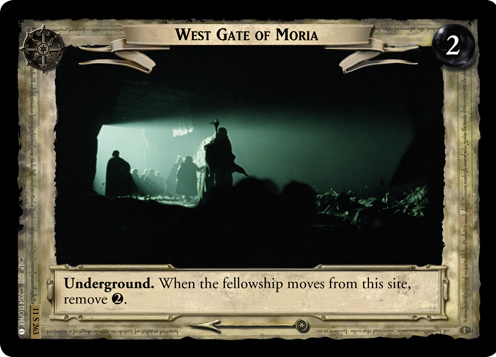
-
Isenwash (13U193)
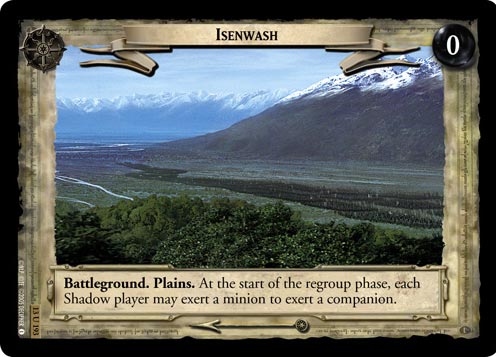
-
Rohan Uplands (11S257)
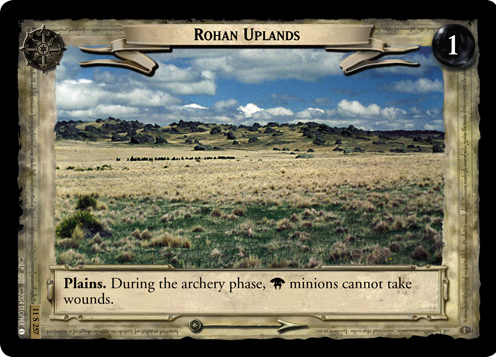
-
Anduin Confluence (11S228)
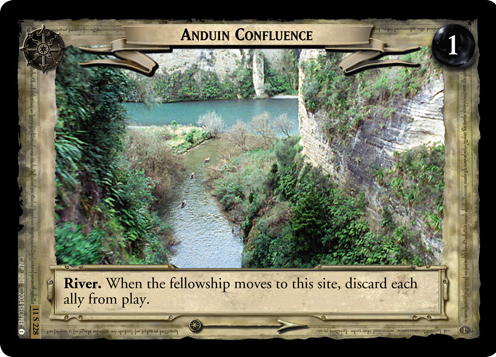
-
Expanding Marshland (11S238)
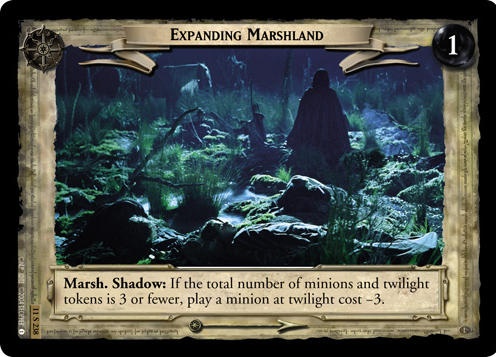
-
The Prancing Pony (11S256)
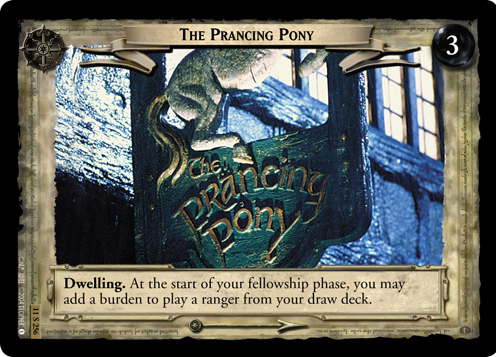
-
Moria Guardroom (11S247)
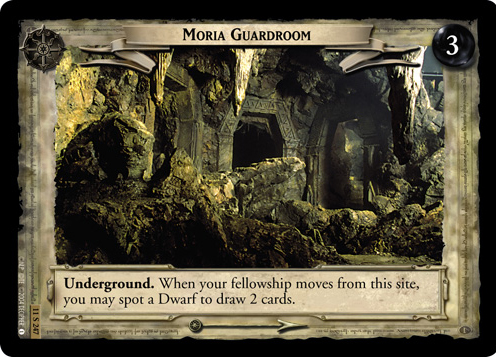
-
Crossroads of the Fallen Kings (13S189)
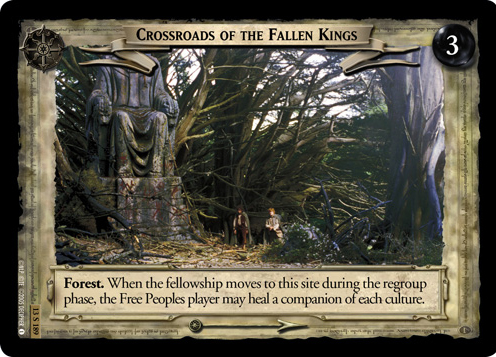
-
Starkhorn (12U193)
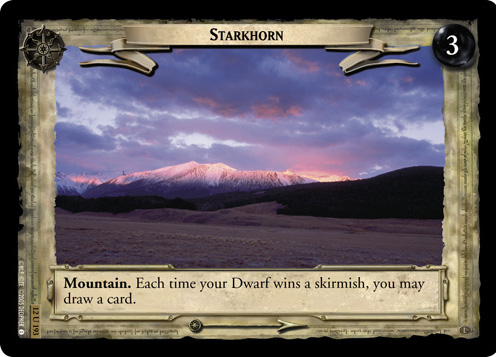
-
Wold Battlefield (12U194)
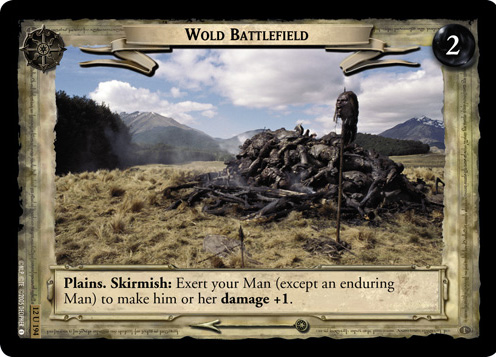
-
Heights of Isengard (11U244)
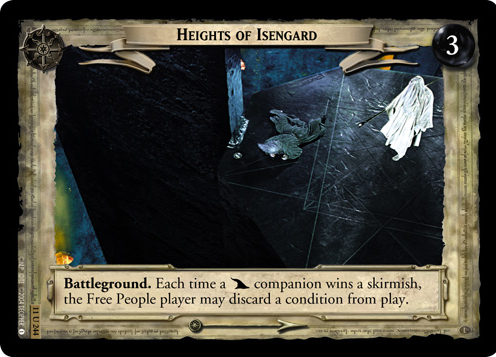
-
Pelennor Fields (11S253)
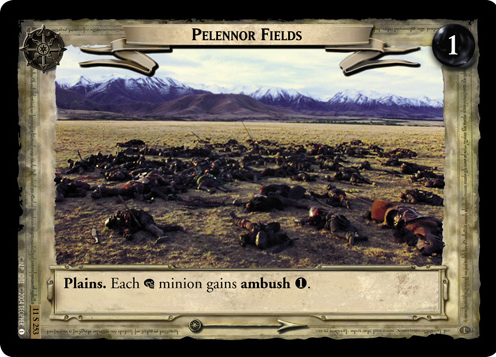
-
City of Kings (13U187)
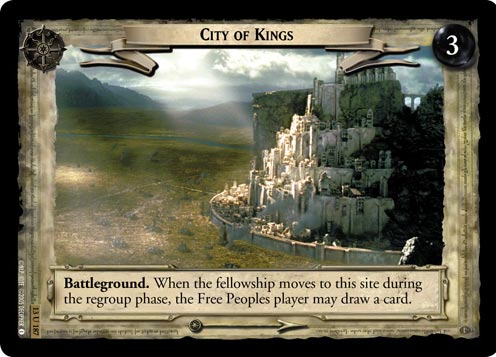
-
Fords of Isen (13S191)
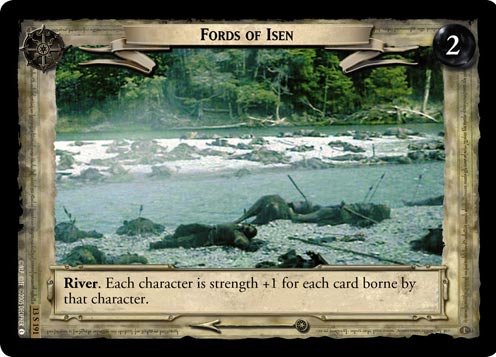
-
Watch-tower of Cirith Ungol (11S262)
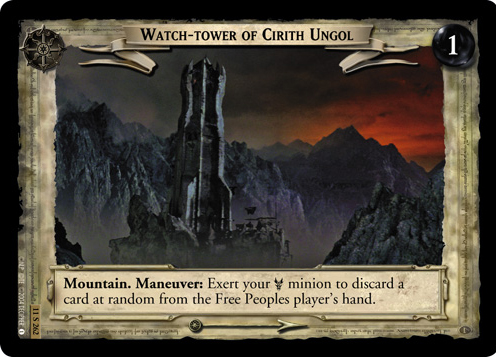
-
Old Forest Road (11S251)
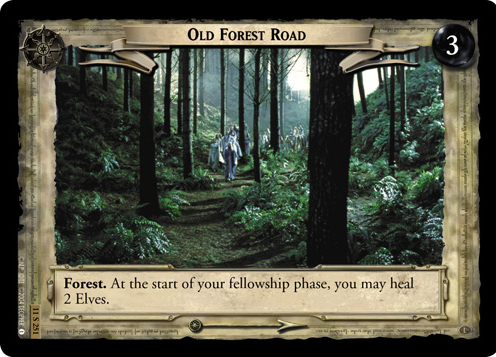
-
Emyn Muil (12S187)
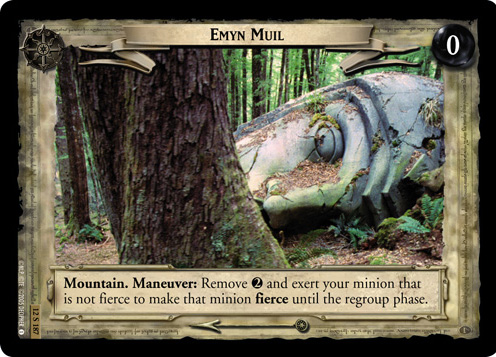
-
Northern Pelennor (12S190)
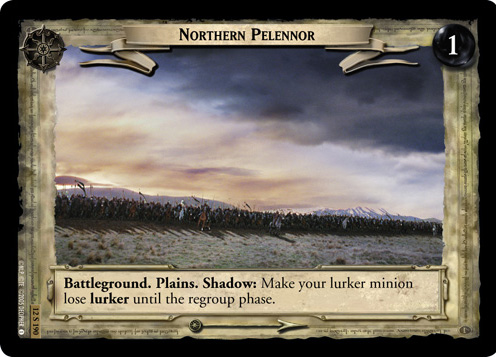
-
Westemnet Village (11S264)
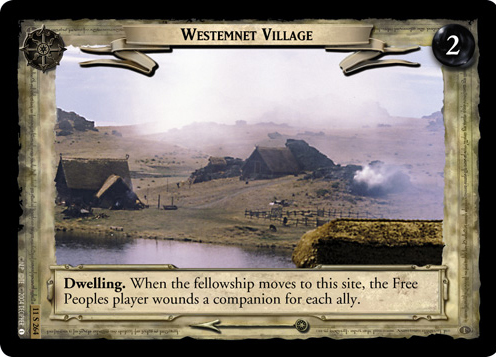
-
Hobbiton Market (12S189)
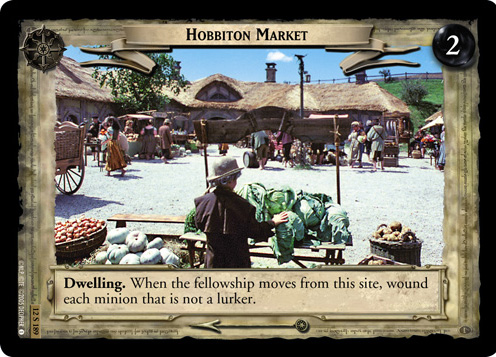
-
Crags of Emyn Muil (11S234)
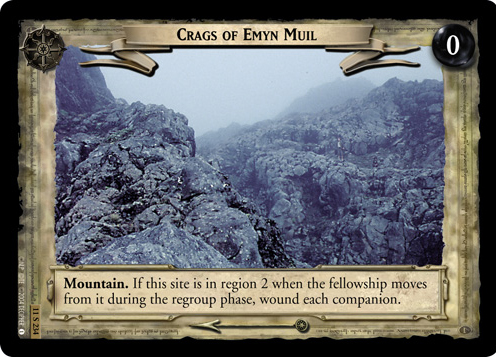
-
Slag Mounds (11S258)
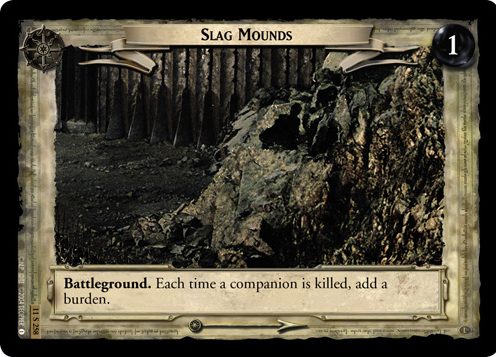
-
Harrowdale (11S243)
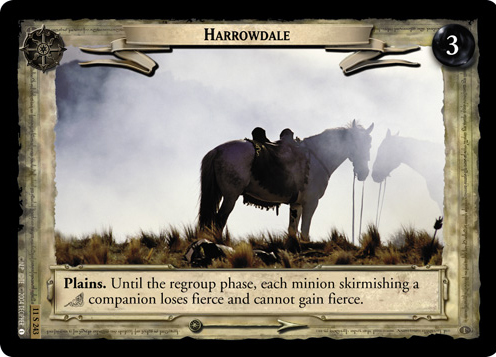
-
Trollshaw Forest (11S260)
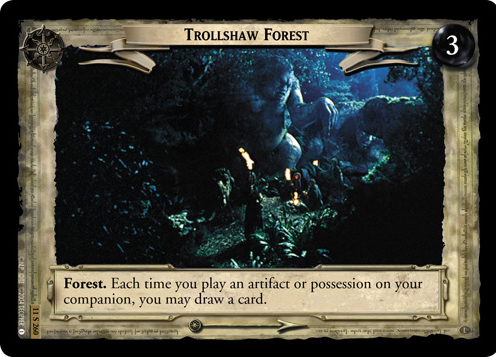
-
North Undeep (11S250)
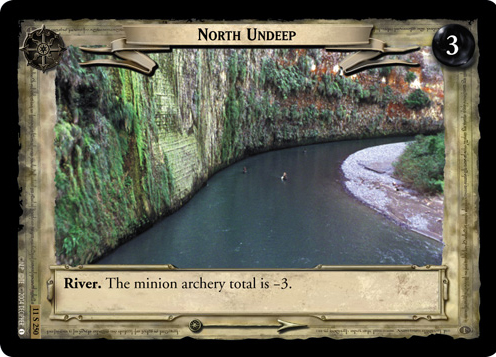
-
Fangorn Glade (11S239)
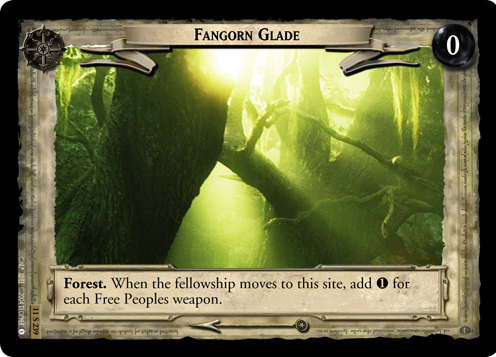
-
The Great Gates (13S192)
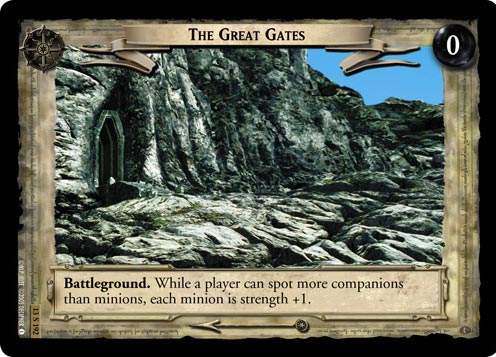
-
Anduin Banks (11U227)
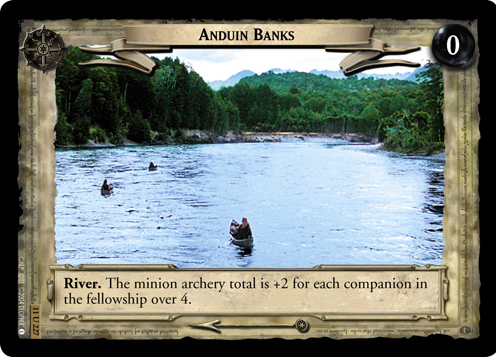
-
Mere of Dead Faces (11U246)
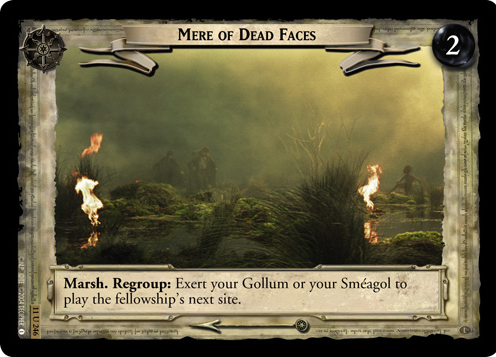
-
Chamber of Mazarbul (11S233)
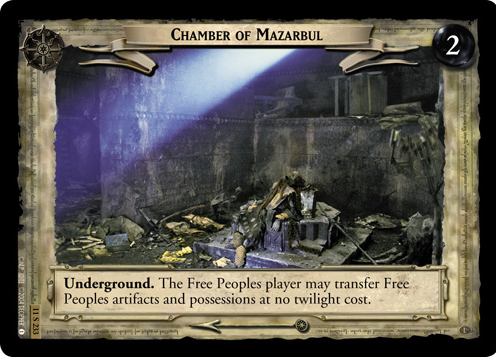
-
Stables (11S259)
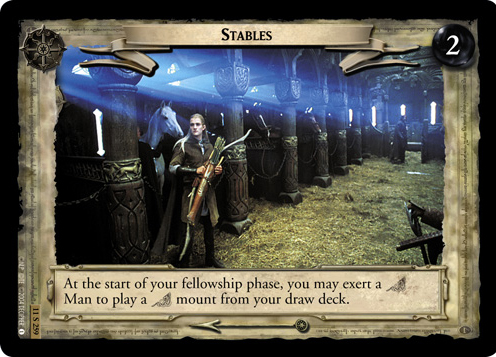
-
Window on the West (11S265)
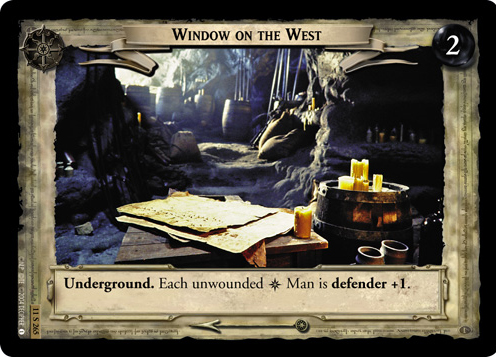
-
Green Dragon Inn (11S242)
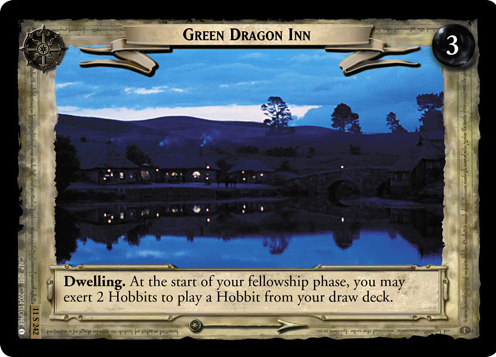
-
Osgiliath Reclaimed (11S252)
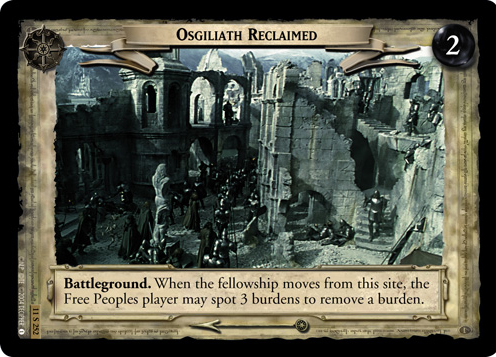
-
Buckland Homestead (11S230)
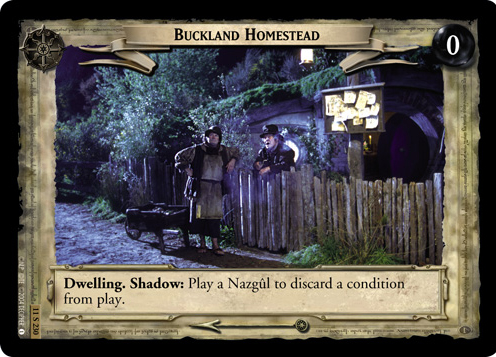
-
Ettenmoors (11S237)
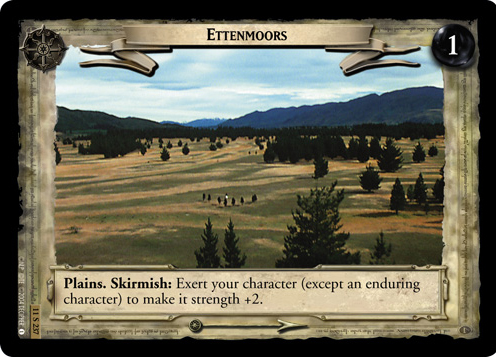
-
Neekerbreekers’ Bog (11S249)
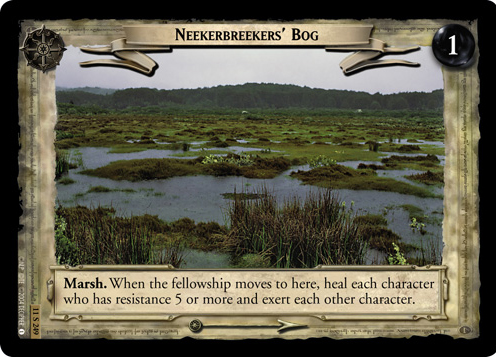
-
Hill of Sight (12S188)
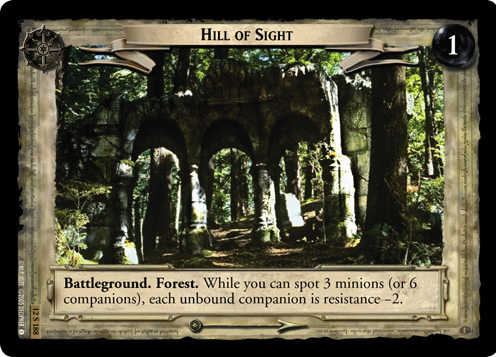
-
Dammed Gate-stream (11U235)
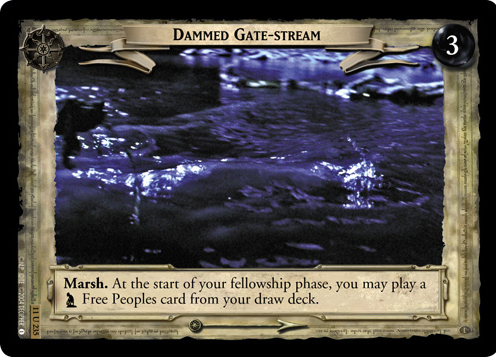
-
Redhorn Pass (13U194)
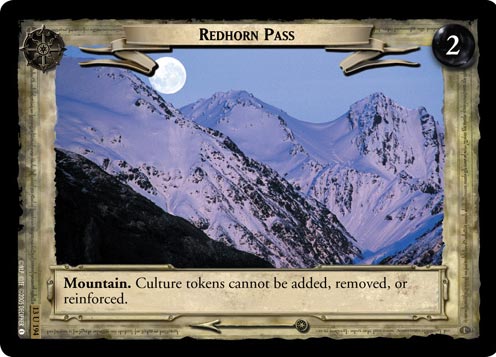
-
Woody-End (11S266)
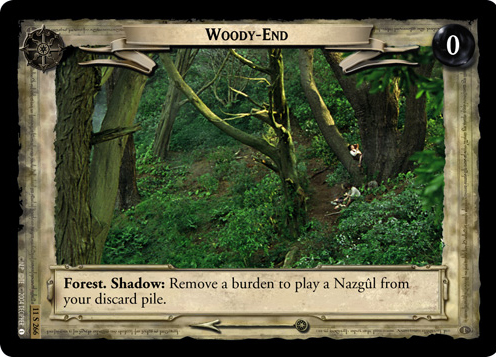
-
Helm's Gate (11S245)
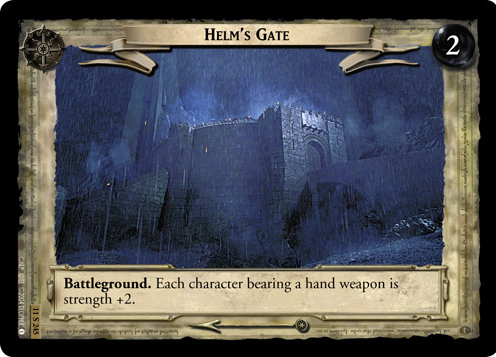
-
Pelennor Flat (11S254)
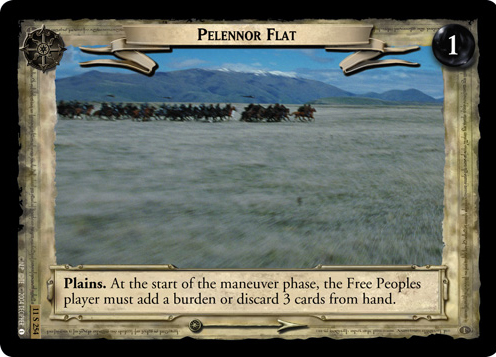
-
Caras Galadhon (11S231)
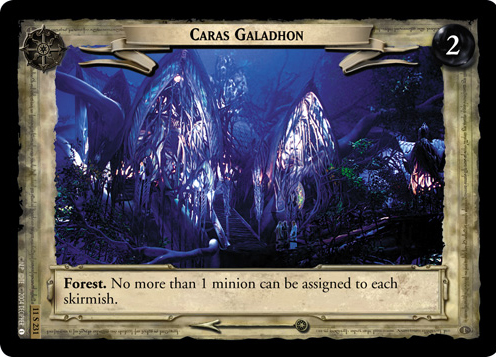
-
Caves of Aglarond (13S186)
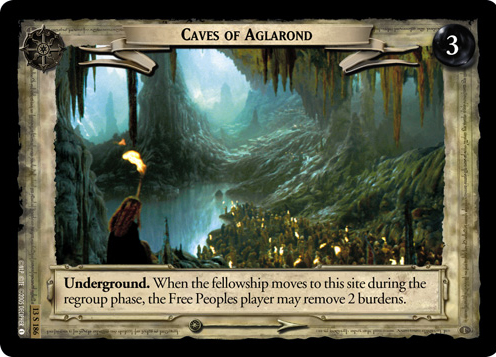
-
The Bridge of Khazad-dûm (12U186)
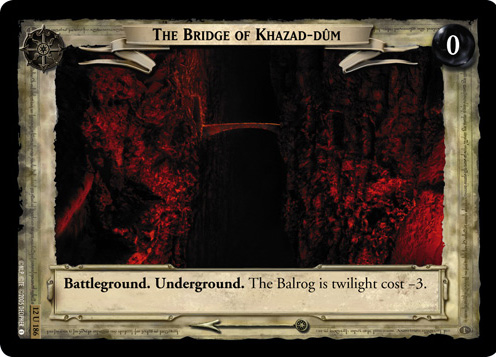
-
Courtyard Parapet (13U188)
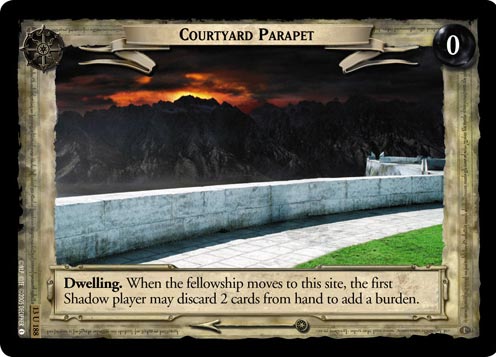
-
Fortress of Orthanc (11S241)
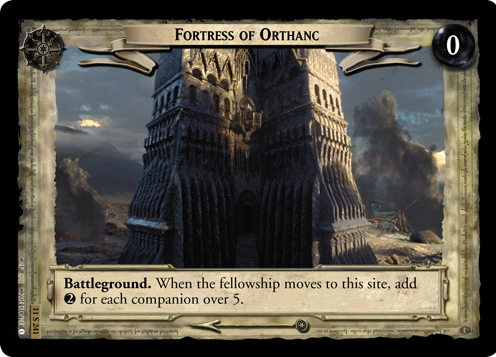
-
Abandoned Mine Shaft (13U185)
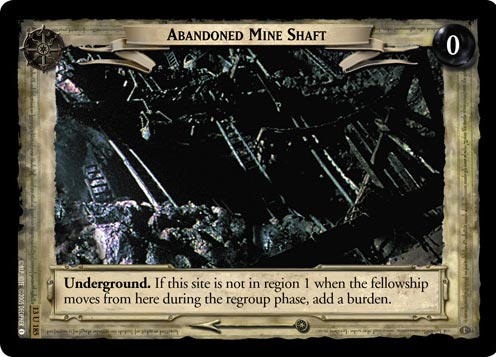
-
Shores of Nen Hithoel (12U191)
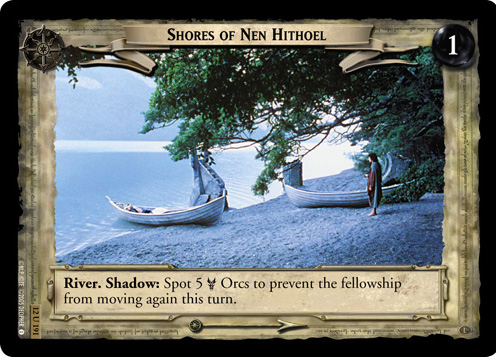
List of Hunters Block Sites[edit]
-
Anduin River (15U187)
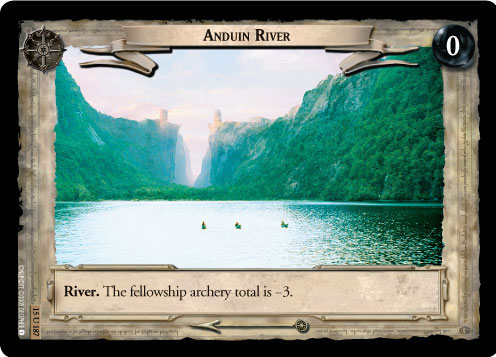
-
Breeding pit of Isengard (15S188)
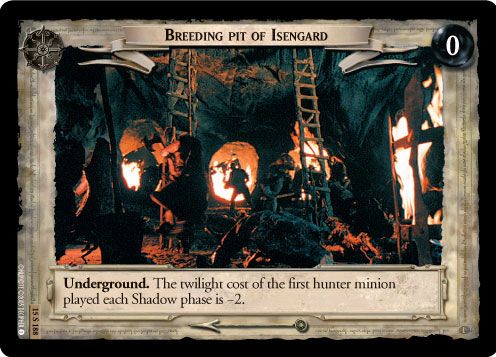
-
City Gates (15S189)
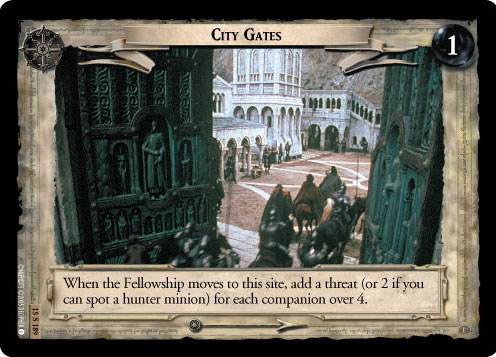
-
East Wall of Rohan (15S190)
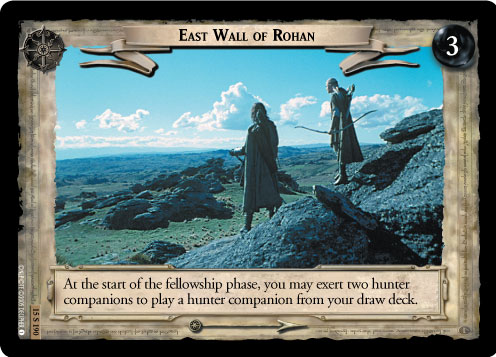
-
Gate of Mordor (15S191)
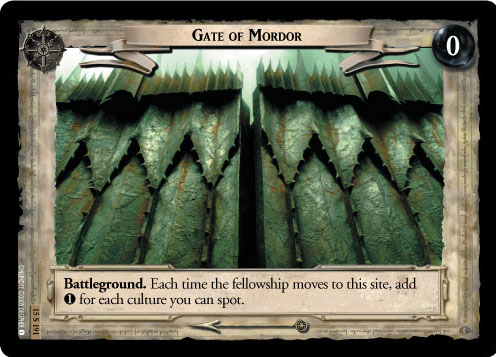
-
Isengard Ruined (15U192)
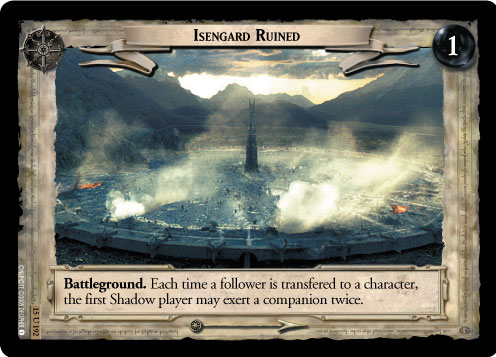
-
Mount Doom (15R193)
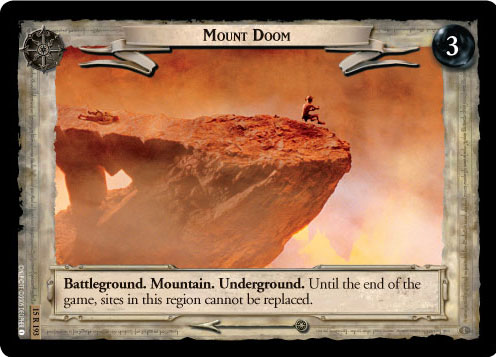
-
Westfold Village (15S194)
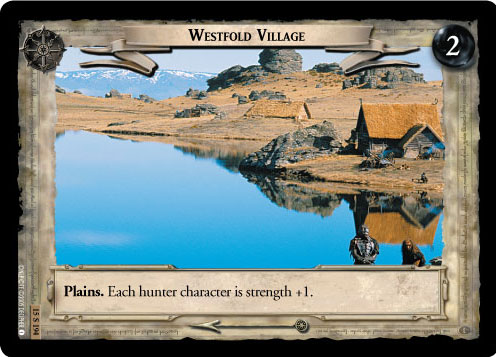
-
Dol Guldur (17U145)
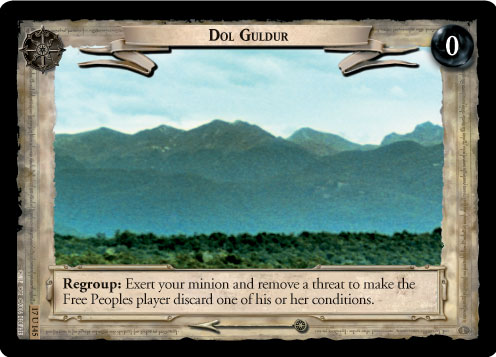
-
Falls of Rauros (17U146)
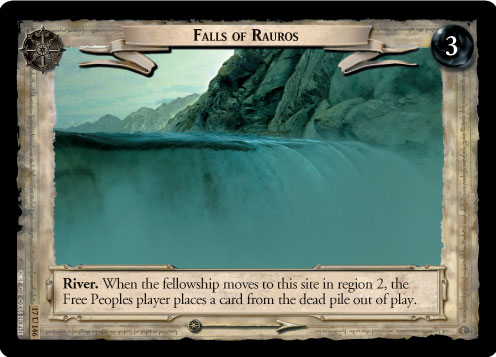
-
Imladris (17U147)
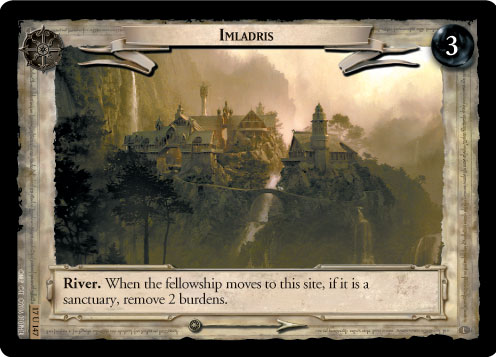
-
Nurn (17U148)
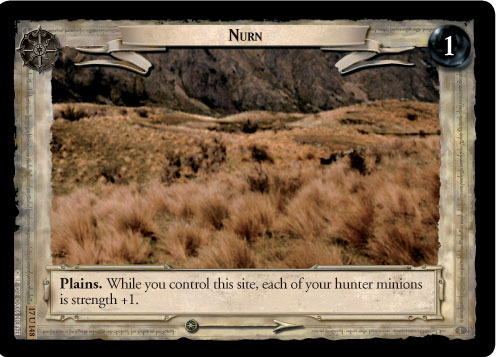
-
Doorway to Doom (18U134)
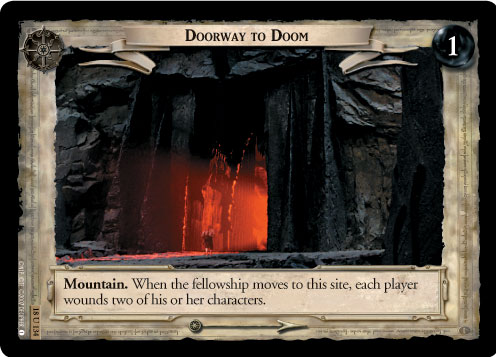
-
Foot of Mount Doom (18U135)
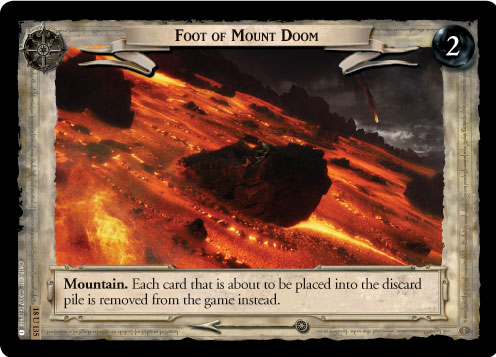
-
Mithlond (18U136)
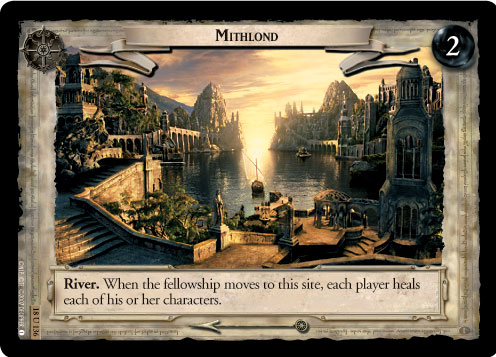
-
Morannon Plains (18U137)
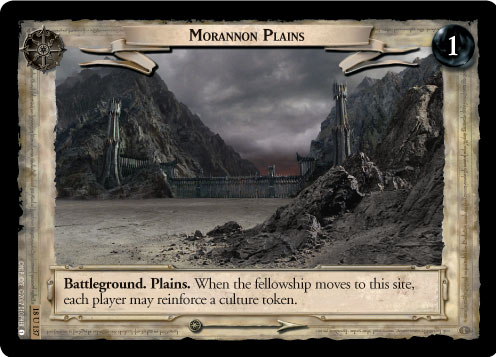
-
Sirannon Ruins (18U138)
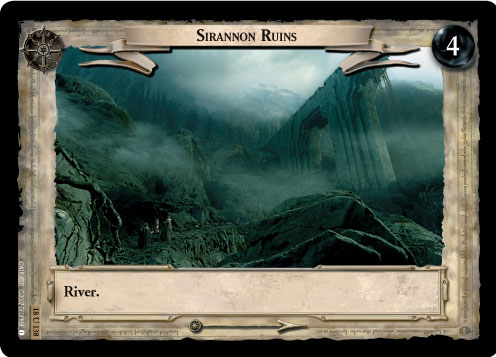
-
Steward's Tomb (18U139)
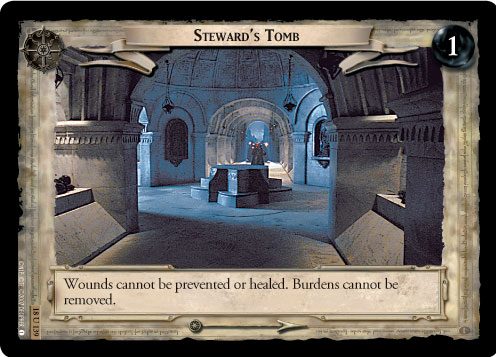
-
Streets of Bree (18U140)
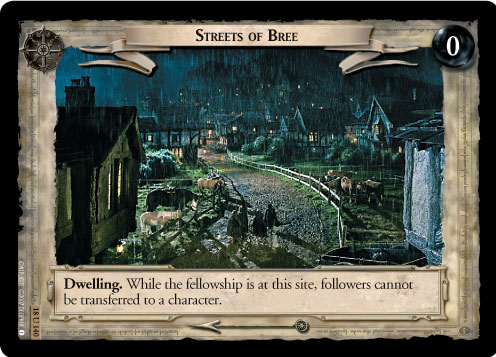
| Card Type | ||||||||||||
|---|---|---|---|---|---|---|---|---|---|---|---|---|
| Layout Used: | Character Layout | Modifier Layout | Site Layout | |||||||||
| Alignment (Kind / Side) | Free Peoples | Companion | Ally | Follower | Artifact | Possession | The One Ring | Condition | Event | Site | ||
| Shadow | Minion | |||||||||||
| Player's Council Card Types | Map | |||||||||||